#modal triad pairs
Text
MINOR TOPIC-EASIER WAY TO IMPROVISE WITH MODES
Minor topic-improvising on modes mad easier for guitar
CLICK SUBSCRIBE!
minor topic-an easier way to improvise with modes of music
IMPORTANT: Please watch video above for detailed info:
Hi Guys,
Today, a quick look at another way of exploiting modes/improvisation on the guitar fingerboard.
We will be creating music via concepts/musical tools based on this minor shape.
Why do this?
Because with this 5 fret shape arpeggio we can easily…

View On WordPress
#easy method#explained#guitar approach notes#guitar target tones#how to#lesson#Minor Topic#modal guitar improv#modal improvisation#modal pentatonics#modal triad pairs#modes#modes made simple#Pat Martino#pentatonic modes#quartal guitar modes#secrest#simple guitar modes#simplifing guitar modes#string skipping modes
1 note
·
View note
Text
🫣
WEEK 1
Personal Tutor:
- Apparently I'm class rep
Principle Study:
- Recap of harmony
Key to reharm is a convincing bass line
Ways to make more 'hot' reharms more palatable for audiences is assigning different instrument sections to different the triads and bass line
Tritones cannot be overused, it will sound like a siren. They should be used in pairs
Minor 11ths sound nice because they have open 4ths in the bottom for the angular sound and triads on top for the round sound
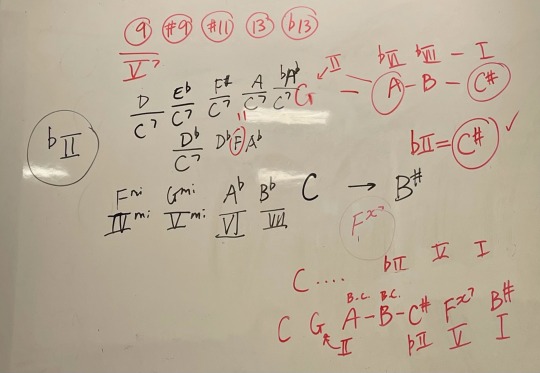
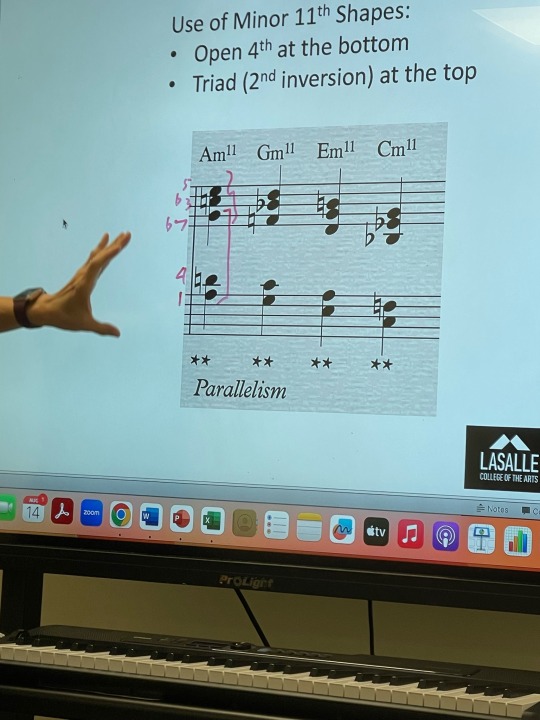
- La Mer (Impressionism, Debussy)
A lot of interwoven textures
Orchestration is very intricate, detailed and delicate
Melodies are more coloristic and make 'impressions', vs clear melody lines
Overall Modal harmony, sounds pentatonic
A lot of planing
Things to listen :
Tours du Monde Tours du Ciel - Suite - Georges Delerue
George Delerue Contempt Theme de Camille 1963
Reflection:
Realised I have a a big year ahead of me, and I want to consciously make more of an effort to stay on top of things, especially with balancing school work with my commitments outside of school.
This means scheduling time to do work, which I've never done in the past. I've adopted the habit of setting alarms to get tasks done throughout the day.
Me, Shyvon and Maegan have made a pact to journal every week together to ensure we pace ourselves ad not die last minute. Furthermore, we will nag each other consistently.
As I have learnt from listening to Formula 1 podcast's, motto this semester is to be FIERCELY OPTIMISTIC.
15/8/23

0 notes
Text
Glycemic Control and Sleep Quality Response to Life Style Modification among Obese Type 2 Diabetic Patients- Juniper Publishers
Abstract
Background: Recently attention is directed to the potentially negative reinforcing relationships that may exist between sleep disturbance, obesity and type 2 diabetes mellitus (T2DM) as good sleep quality is crucial for maintaining an effective glycemic control and improving the quality of life of patients with diabetes.
Objective: The aim of the study was to investigate the effects of weight reduction via life style intervention on glycemic control and sleep quality among obese type 2 diabetic patients.
Material and methods: Eighty obese T2DM patients (43 males and 37 females) with body mass index (BMI) ranged from 30 to 36Kg/m2, their age ranged from 42-56 years were selected from the outpatient diabetic clinic of the King Abdulaziz Teaching Hospital were randomly assigned to life style intervention group (group A, n=40) or control group (group B, n=40). Polysomnographic recordings for sleep quality assessment, body mass index (BMI), the quantitative insulin-sensitivity check index (QUICKI), homeostasis model assessment-insulin resistance index (HOMA-IR), glycosylated hemoglobin (HbA1c) were measured before and after 6 months at the end of the study.
Results: There was a significant increase in the mean value of total sleep duration, sleep efficiency, sleep onset latency and QUICKI in group (A) after 6 months of aerobic exercise training, while, awake time after sleep onset, rapid eye movements (REM) latency, BMI, HOMA-IR) and glycosylated hemoglobin (HBAlc significantly reduced after 6 months of life style intervention, however the results of the control group were not significant. Moreover, there were significant differences between both groups at the end of the study.
Conclusion: Life style intervention is an effective modality for modifying glycemic control and sleep quality among obese type 2 diabetic patients.
Keywords: Glycemic control; Sleep quality; Life style intervention; Obesity; Type 2 diabetes mellitus
Introduction
Type 2 diabetes mellitus (T2DM) prevalence has been rising steadily over the past 3 decades, and is largely attributable to the dramatic increase in obesity rate [1,2]. Over 300 million people worldwide live with diabetes now, and if the current prevalence rate continues unabated, over 550 million people will be living with diabetes by 2030 [3,4]. Diabetes represents a major health problem because of its high prevalence, morbidity and mortality, its influence on patient quality of life, and its impact on the health system [5-7].
The quality of sleep is relevant to the regulation of energy and glucose homeostasis [8]. Type 2 diabetes mellitus is a serious chronic disease whereby the body ineffectively use glucose as a fuel due to relative insulin deficiency caused by insulin resistance [9]. Impairments in the daily sleep/wake cycle due to sleep disturbances, including shift working, obstructive sleep apnea, and insomnia, are known to increase the risk of T2DM [10]. Tang and colleagues reported insufficient sleep quality and quantity as a risk factor of developing T2DM and poor glycemic control among sufferers [11]. Sleep duration has also been associated with higher risk of developing T2DM as well representing a strong predictor of glycosylated hemoglobin (HbA1c), with sleep loss being associated with increased HbA1c [12]. The Pittsburgh Sleep Quality Index (PSQI) factor "sleep efficiency” is one of the components that can influence glycemic control [13]. A previously published study suggests negative correlation between HbAlc and sleep efficiency [14].
The strong association between obesity and sleep disorders and disturbances is in line with past research regarding the negative impact of excess weight [15-17]. Obesity, a disease associated with its own litany of health consequences and symptomatology, has been independently associated with an increased risk of sleep disorders, disruptions and poor sleep quality [15]. For example, excess weight is a strong predictor of daytime sleepiness and sleep-disorders [17].
A number of epidemiological studies describe a connection between T2DM, and sleep disorders [18]. Studies suggest that a high proportion of T2DM sufferers also manage comorbid sleep apnea, particularly males and those overweight. Estimates from recent studies range from 18% to 36%, suggesting the importance of addressing sleep disorders among this patient group [19-21]. A large-scale survey study found that sleep problems were by up to 40% of individuals with T2DM, with sleep apnea, and restless legs symptoms the most likely among sufferers [22]. Individuals with T2DM who are obese also frequently report sleep problems, with research suggesting that all three may represent a complex interwoven triad of conditions [23,24].
The aim of the study was to investigate the effects of weight reduction via life style intervention on glycemic control and sleep quality among obese type 2 diabetic patients.
Patients and Methods
Subjects
Eighty obese T2DM patients (43 males and 37 females) with body mass index (BMI) ranged from 30 to 36Kg/m2, were selected from the outpatient diabetic clinic of the King Abdalziz Teaching Hospital. They were checked for fasting/random glucose levels. Only participants have fasting blood sugar levels more than 5.6mmol/l or random blood sugar level more than 7.8mmol/l (impaired blood sugar) were included in this study and were further checked for type 2 diabetes mellitus as per recent American Diabetes Association criteria i.e. fasting blood sugar ≥7.0mmol/l or post-prandial blood sugar ≥11.1 mmol/l (2h plasma glucose 11.1 mmol/l during an oral glucose tolerance test) and glycosylated hemoglobin (HbA1c%) > 6.5% [25]. Exclusion criteria included history of major psychiatric disorder as mania or alcohol or substance abuse or other neurological disorders, significant depressive symptoms, kidney insufficiency, congestive heart failure, pregnant female patients, hepatitis and respiratory failure, current use or use within the past month of psychoactive, hypnotic, stimulant or analgesic medications, shift work or other types of self-imposed irregular sleep schedules, smoking or caffeine consumption greater than 300mg per day. A detail clinical history and physical examinations were conducted which included the age, sex, symptoms suggestive of diabetes and family history of diabetes. Physical examinations included anthropometric measurements such as height, weight, body mass index (BMI) and waist circumference. Participants were included two groups; group (A) received treadmill aerobic exercise training on treadmill and diet regimen. However, group (B) was considered as a control group and received no exercise training or diet regimen. A cardiologist conducted an initial clinical examination for all participants and participants were randomized for a weight reduction group (group A) or control group (group B). This study was approved by the Ethical Committee for Scientific Research, Faculty of Applied Medical Sciences, King Abdulaziz University. All participants provided written informed consent.
Measurements
Sleep measures: All participants underwent polysomnographic (PSG) recording before and after the exercise training. For the pre-intervention assessment, PSG recording was performed over 2 nights. The first night served as an adaption night; 48 hour later, the participants returned for another night of PSG recording. The post-training PSG assessment occurred at least 30 hours after the last exercise session. The participants arrived at the sleep laboratory at 21:00; the PSG recording started and finished according to each volunteer's habitual sleep schedule. The room used for the recordings had a large comfortable bed, acoustic isolation, and controlled temperature and light. A trained sleep technician using a digital system (Philips-Respironics, USA) conducted recordings. The following parameters were analyzed:
I. Total sleep time (in min), defined as the actual time spent asleep;
II. Sleep latency (in min), defined as the time from lights out until the onset of three consecutive epochs of stage 1 or deeper sleep;
III. Sleep efficiency, defined as the percentage of total recording time spent asleep;
IV. Wake after sleep onset (in min), defined as the total time scored as wakefulness between sleep onset and final awakening;
V. Sleep stages 1, 2, 3, and 4 as well as REM sleep as percentages of total sleep time; and
VI. Latency to REM, defined as the time from sleep onset until the first epoch of REM sleep [26].
Chemical analysis: Blood samples were collected from the antecubital vein at the beginning and end of the treatment program. Subjects had blood drawn at the same time in the morning on each occasion (between 8 and 10AM). Subjects lay supine for 10 min prior to the blood collection. 10ml of blood was drawn into a tube containing few milliliters of sodium citrate; plasma was separated from the blood by centrifugation (120-x g for 15min) at room temperature to determine level of glycosylated hemoglobin (HBA1c). However, human insulin was measured with an insulin kit (Roche Diagnostics, Indianapolis, IN, USA) using a cobas immunoassay analyzer (Roche Diagnostics). Insulin resistance was assessed by homeostasis model assessment (HOMA-IR). HOMA-IR = [fasting blood glucose (mmol/l) _ fasting insulin (mlU/ml)]/22.5 [27]. However, insulin sensitivity was assessed by The quantitative insulin-sensitivity check index (QUICKI) using the formula: QUlCKl=1/(log(insulin) + log(glucose)) [28]. All samples were assayed in duplicate, and the mean of the paired results was determined.
Measurement of anthropometric parameters: Body weight of all participants was measured with (HC4211, Cas Korea, South Korea) while wearing hospital gowns and undergarments. Where the height was measured with a digital stadiometer (JENIX DS 102, Dongsang), so Body Mass Index (BMI) was computed as BMI= Body weight/Height2.
Procedures
Following the previous evaluation, all patients were divided randomly into the following groups:
Patients in group (A): Were submitted to forty minutes moderate intensity aerobic exercise sessions on a treadmill (the initial, 5-minute warm-up phase performed on the treadmill (Enraf Nonium, Model display panel Standard, NR 1475.801, Holland) at a low load, each training session lasted 30 minutes and ended with 5-minute recovery and relaxation phase) either walking or running, based on heart rate, until the target heart rate was reached, according to American College of Sport Medicine guidelines [29]. The program begun with 10min of stretching and was conducted using the maximal heart rate index (HRmax) estimated by 220-age. First 2 months = 60-70% of HRmax second 4 months = 70-80% of HRmax . Each session was continued for 30 minutes; 3 sessions / week for 3 months [30]. All subjects of group (A) were instructed to take an individual balanced energy-restricted dietary program to obtain weight loss .The mean daily caloric intake was about 1200kcal/day, based on a macronutrient content <30% fat and 15% protein as recommended by the World Health Organization [31]. At the initial interview with a dietitian, obese subjects was given verbal and written instructions on how to keep diet records, with food weighed and measured. The same dietitian monitored dietary intake. The subjects maintained a detailed record of food intake, and received weekly nutritional counseling. Obese subjects were instructed to substitute low-fat alternatives for typical high-fat foods, to increase the consumption of vegetables and fresh fruits, and to substitute complex carbohydrates, such as whole-grain bread and cereals. Dietetic help was given every 2 weeks by the dietitian when anthropometric measurements were performed; in addition, each subject was seen by a physician monthly to perform a clinical evaluation, standard electrocardiogram, and measurement of blood pressure and heart rate [32].
Patients in group (B): Received no training or diet regimen for three months.
Statistical analysis
The mean values of the investigated parameters obtained before and after six months in both groups were compared, using paired "t” test. Independent "t” test was used for the comparison between the two groups (P<0.05).
Results
The two groups were considered homogeneous regarding the demographic variables. The mean age of the group (A) was 49.58±5.61 years, and the mean age of group (B) was 47.32±5.44 years. There was no significant differences in age, body mass index (BMI), duration of diabetes, body fat, systolic blood pressure, diastolic blood pressure, fasting glucose, hemoglobin A1c (HbA1c), serum insulin and blood lipids between both groups (Table 1).
BMI = Body Mass Index; HbA1c = Glycosylated Hemoglobin; HDL= High Density Lipoprotein; LDL= Low Density Lipoprotein
BMI: Body Mass Index; QUICKI: The quantitative insulin-sensitivity check index; HOMA-IR: Homeostasis Model Assessment-Insulin Resistance Index; HbA1c = Glycosylated Hemoglobin; REM: rapid eye movements; (*) indicates a significant difference, P < 0.05.
BMI: Body Mass Index; QUICKI: The quantitative insulin-sensitivity check index; HOMA-IR: Homeostasis Model Assessment-Insulin Resistance Index; HbA1c = Glycosylated Hemoglobin; REM: rapid eye movements.
BMI: Body Mass Index; QUICKI: The quantitative insulin-sensitivity check index; HOMA-IR: Homeostasis Model Assessment-Insulin Resistance Index; HbA1c = Glycosylated Hemoglobin; REM: rapid eye movements; (*) indicates a significant difference between the two groups, P < 0.05.
There was a significant increase in the mean value of total sleep duration, sleep efficiency, sleep onset latency and the quantitative insulin-sensitivity check index (QUICKI) in group (A) after 6 months of aerobic exercise training, while, awake time after sleep onset, rapid eye movements (REM) latency, body mass index (BMI), Homeostasis Model Assessment-Insulin Resistance Index(HOMA-IR) and glycosylated hemoglobin (HBAlc) significantly reduced after 6 months of life style intervention (Table 2), however the results of the control group were not significant (Table 3). In addition, there were significant differences between both groups at the end of the study (Table 4).
Discussion
The prevalence of sleep disturbances and deprivation has been increasing dramatically over the past decade, together with the growing epidemic of type 2 diabetes mellitus (T2DM) and obesity worldwide. Several meta-analyses have confirmed the independent association between sleep duration and sleep quality with the risk of developing T2DM [33,34], However, Gupta and colleagues reported that about 25% of patients with T2DM were diagnosed with sleep disorders (SD) and over 75% reported experiencing at least one sleep symptom regularly, where SD and symptoms were strongly associated with obesity [35]. Recent epidemiological studies have suggested that there is an association between glycemic control and sleep disturbances in patients with T2DM [36], therefore effective weight management treatment in T2DM patient implemented in the primary care setting [37]. The aim of the study was to investigate the effects of weight reduction via life style intervention on glycemic control and sleep quality among obese type 2 diabetic patients.
Concerning sleep quality parameter, there was a significant increase in the total sleep duration, sleep efficiency and sleep onset latency in group (A) after 6 months of life style intervention (aerobic exercise and diet regimen), while, awake time after sleep onset and REM latency significantly reduced compared with values obtained prior to life style intervention (Table 2). To the best of our knowledge, this is the first study for life style intervention and quality of sleep among type 2 diabetic patients as all previous studies were concerned with the life style intervention and obstructive sleep apnea and the impact of exercise training and quality of sleep.
Reid et al had Seventeen sedentary elderly subjects with insomnia who had 16 weeks of aerobic physical activity. The clearly stated that physical activity improved sleep quality on the global Pittsburgh Sleep Quality Index (PSQI) score, sleep latency sleep duration, daytime dysfunction and sleep efficiency [38]. Where, Lira et al. conducted a study on fourteen male sedentary, healthy, elderly volunteers performed moderate training for 60 minutes/day, 3 days/week for 24 weeks at a work rate equivalent to the ventilatory aerobic threshold. They proved that sleep parameters, awake time and REM sleep latency decreased after 6 months exercise training in relation baseline values [39]. In addition, Yang and colleagues completed a systematic review with meta-analysis of six randomized trials and provided data on 305 participants (241 female). Each of the studies examined an exercise training program that consisted of either moderate intensity aerobic exercise or high intensity resistance exercise. The duration of most of the training programs was between 10 and 16 weeks. All of the studies used the self-reported Pittsburgh Sleep Quality Index to assess sleep quality. Compared to the control group, the exercise group had significantly reduced sleep latency and medication use [40]. While, Chen and coworkers enrolled twenty-seven participants in 12 weeks of Baduanjin exercise training, they proved that overall sleep quality, subjective sleep quality, sleep latency, sleep duration, sleep efficiency, and daytime dysfunction significantly improved after 12 weeks of intervention [41]. In addition, Santos et al had twenty-two male, sedentary, healthy, elderly volunteers performed moderate training for 60min/day, 3 days/week for 24 week at a work rate equivalent to their ventilatory aerobic threshold, their findings suggest that aerobic exercise training increased aerobic capacity parameters, decreased REM latency and decreased time awake [42]. Moreover, Passos and colleagues concluded that a 4-month intervention of moderate aerobic exercise delivered to twenty- one sedentary participants with chronic primary insomnia had polysomnographic data significantly improvements following exercise training, where total sleep time, sleep efficiency and rapid eye movements significantly increased. In addition, sleep onset latency and wake time after sleep onset significantly decreased following exercise training [43].
Regarding, the mechanism underlying the effect of life style intervention on sleep, although the mechanisms by which life style intervention can improve sleep quality are not well understood. However, extra energy consumption, endorphin secretion, secretion of anti-inflammatory cytokines or modulation of body temperature in a manner that facilitates sleep for recuperation of the body in addition to reduced resting plasma concentrations of pro-inflammatory cytokines may be the possible mechanisms for sleep quality parameter improvement because of life style intervention [40,44-47].
Regarding glycemic control, the results of the present study proved that life style intervention (aerobic exercise and diet regimen) significantly improved insulin sensitivity and reduced insulin resistance because of weight reduction. These results agreed with Angelico et al. proved that 5%-10% weight loss as a result of diet regimen modulates insulin resistance in patients with metabolic syndrome [48], also Albu and colleagues mentioned that lifestyle modifications with diet and exercise are essential part of the management of the diabetes obese patient as weight loss leads to improvement in the glucose tolerance, insulin sensitivity, reductions in lipid levels [49]. While, weight reduction program consisted of diet restriction and exercise, which was conducted on thirty-five obese T2DM patients for twelve weeks (diet restriction and exercise), induced significant reductions in body weight, serum leptin levels, improvements in lipoprotein profile, insulin sensitivity and glucose control [50]. Several mechanisms have been proposed to be responsible for the increases in insulin sensitivity after exercise training. These include increased post-receptor insulin signaling, increased glucose transporter protein and mRNA, increased activity of glycogen syntheses and hexokinase, decreased release and increased clearance of free fatty acids, increased muscle glucose delivery and changes in muscle composition [51]. Moreover, energy restriction resulting in even modest weight loss suppresses endogenous cholesterol synthesis that leads to a decline in circulating lipid concentrations and because of increased insulin sensitivity [52,53]. Through decreasing deposition of total fat and intra-abdominal fat [54].
Conclusion
Life style intervention is an effective modality for modifying glycemic control and sleep quality among obese type 2 diabetic patients.
For more about Juniper Publishers please click on:https://twitter.com/Juniper_publish
For more about Journal of Thyroid Research please click on: https://juniperpublishers.com/jetr/index.php
0 notes
Text
Harmonic and Melodic Equivalence V7

Harmonic and Melodic Equivalence V7
Get this book for one dollar with promo code
buckbook
Harmonic and Melodic Equivalence V7
Add digital copy to cart - $19.99
Status: In stock, Digital book is available for immediate access.
Melodic Rotations Learning to Improvise More Based on the Composition
"Harmonic and Melodic Equivalence" is a series of books that will help you to develop many different musical skills simultaneously. The source materials for these books are exercises that contain two 3 note groupings, also called "trichords," that are manipulated in various ways. These exercises use many different types of harmonic and melodic ideas that can be superimposed over common chord progressions, scales and other musical situations. The exercises found in these courses are also great for singing and rhythm studies. Finally, the "Harmonic and Melodic Equivalence" course concentrates on the use of the three note pitch class sets (trichords) by pairing each trichord with another trichord with the same prime form. For instance, in this volume C, F#, G and Eb, A, Bb which are two 016 pitch class sets. This is a an extremely important pitch class set to learn because it is a replacement for a dominant chord. It also is part of a symmetrical diminished scale and is a great replacement for a minor, dominant or diminished chord.
Harmonic and Melodic Equivalence Exercises
This course is divided up into two sets of exercises written in treble and bass clef. The 1st set of exercises gets gradually harder but also more musical. Depending upon your musical skills you can start anywhere you want but for beginners I would recommend starting from the 1st exercise of the five. The 2nd set of exercises are called "Atomic Scales." These exercises are a technical exercise that really helps you to learn these ideas but also sound great as a melody right off the bat. There are 6 different types of "Atomic Scales" exercises in this course. You don't have to play every exercise in every key. But doing this will greatly increase the likelihood of you using it in real music in the future. Below is a listing of the exercises found in this course:
Closed position studies.
1st inversion studies.
2nd inversion studies.
Random combinations of closed position along with 1st and 2nd inversion.
Random combinations of closed position along with 1st and 2nd inversion with rhythmic displacement.
Atomic Scales Exercise 1
Atomic Scales Exercise 2
Atomic Scales Exercise 3
Atomic Scales Exercise 4
Atomic Scales Exercise 5
Atomic Scales Exercise 6
Explanation of 2nd Set of Exercises in Harmonic and Melodic Equivalence V7 Course
Below is an explanation for each set of the 6 different atomic scale exercises found in this course. Three octave sequences that move back and forth between the two 3 note groups are presented in six different configurations. These exercises are highly melodic and can be used verbatim as melodies when soloing. If we thought of the three notes as A,B,C then there would be six different ways to combine these notes. i.e. ABC, ACB, BAC, BCA, CAB and CBA. All exercises include MP3s as well as midi files so that you can hear and play these exercises at any tempo as well as versions in all 12 keys.
Three octave sequences that move back and forth between the two 3 note groups in the ABC sequence
Three octave sequences that move back and forth between the two 3 note groups in the ACB sequence
Three octave sequences that move back and forth between the two 3 note groups in the BAC sequence
Three octave sequences that move back and forth between the two 3 note groups in the BCA sequence
Three octave sequences that move back and forth between the two 3 note groups in the CAB sequence
Three octave sequences that move back and forth between the two 3 note groups in the CBA sequence
1st Set of Exercises in Harmonic and Melodic Equivalence V7 Course
Here are a few examples from the 1st set of exercises. A complete list of the different types of exercises can also be found below.
Closed Position Exercise
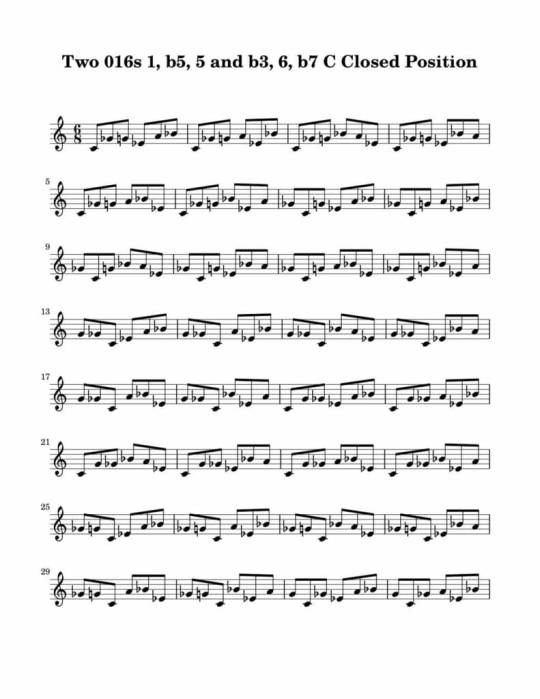
MP3 example
https://s3.amazonaws.com/media.muse-eek.com/mp3/HandMEV7/01_016_016_Degree_1_b3_b5_5_6_b7_Closed_Position_Key_C.mp3
1st Inversion Exercise
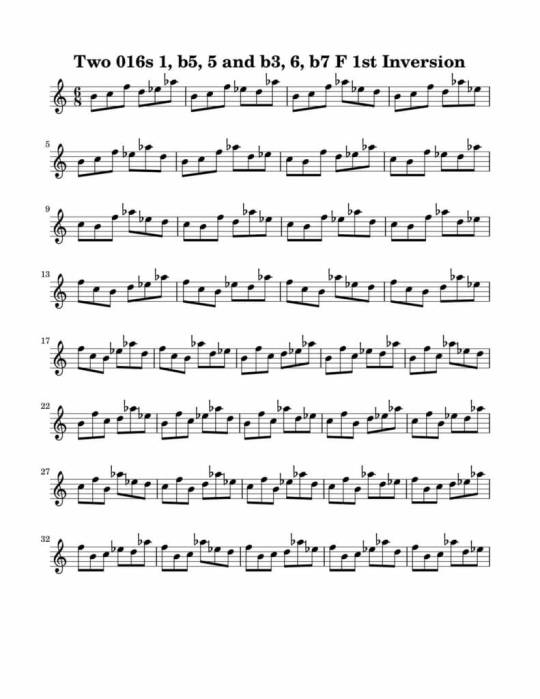
MP3 example
https://s3.amazonaws.com/media.muse-eek.com/mp3/HandMEV7/02_016_016_Degree_1_b3_b5_5_6_b7_1st_Inversion_Key_F.mp3
2nd Inversion Exercise
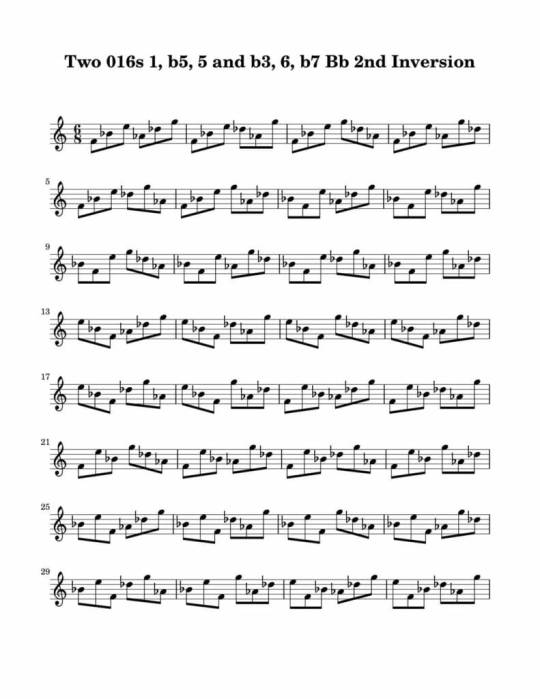
MP3 example
https://s3.amazonaws.com/media.muse-eek.com/mp3/HandMEV7/03_016_016_Degree_1_b3_b5_5_6_b7_2nd_Inversion_Key_Bb.mp3
Random combinations of closed position along with 1st and 2nd inversion.
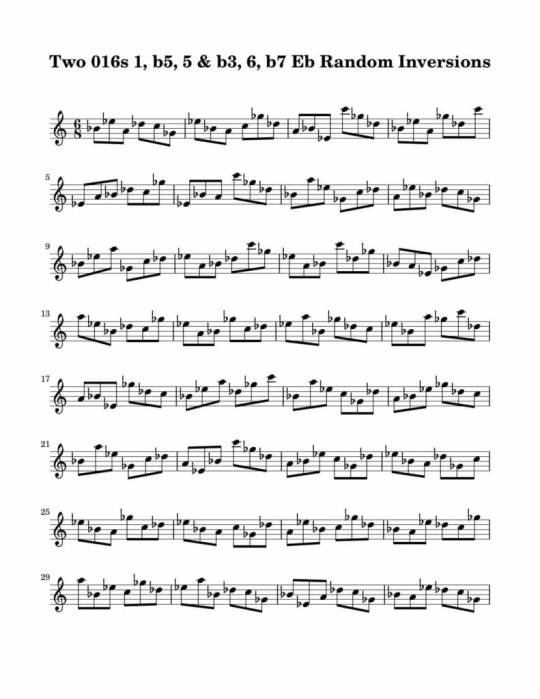
MP3 example
https://s3.amazonaws.com/media.muse-eek.com/mp3/HandMEV7/04_016_016_Degree_1_b3_b5_5_6_b7_Random_Inversions_Key_Eb.mp3
Random combinations of closed position along with 1st and 2nd inversion and rhythm permutation

MP3 example
https://s3.amazonaws.com/media.muse-eek.com/mp3/HandMEV7/05_016_016_Degree_1_b3_b5_5_6_b7_Random_Inv_Rhy_Key_Ab.mp3
2nd Set of Exercises in Harmonic and Melodic Equivalence V7 Course
Here are a few examples from the 2nd set of exercises.
Atomic Scales 1st Rotation

MP3 example
https://s3.amazonaws.com/media.muse-eek.com/mp3/HandMEV7/01_015_027_Degree_1_2_3_5_6_7_Atomic_Scale_Ex_1_Key_C.mp3
Atomic Scales 2nd Rotation

MP3 example
https://s3.amazonaws.com/media.muse-eek.com/mp3/HandMEV7/02_015_027_Degree_1_2_3_5_6_7_Atomic_Scale_Ex_2_Key_F.mp3
Atomic Scales 3rd Rotation
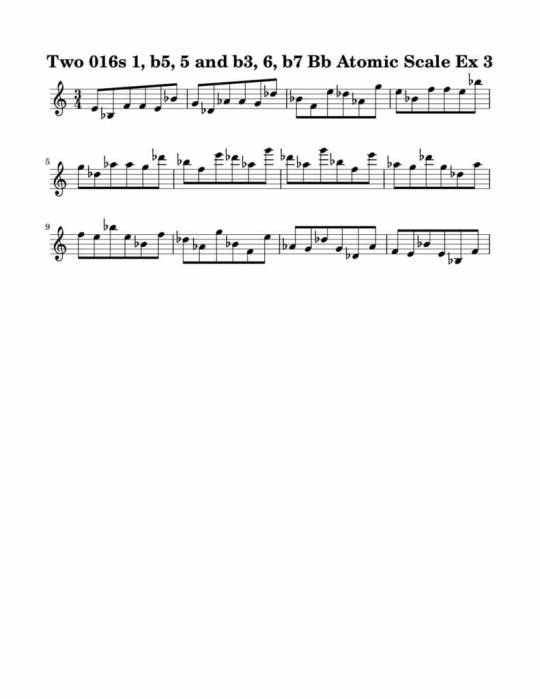
MP3 example
https://s3.amazonaws.com/media.muse-eek.com/mp3/HandMEV7/03_015_027_Degree_1_2_3_5_6_7_Atomic_Scale_Ex_3_Key_Bb.mp3
Atomic Scales 4th Rotation
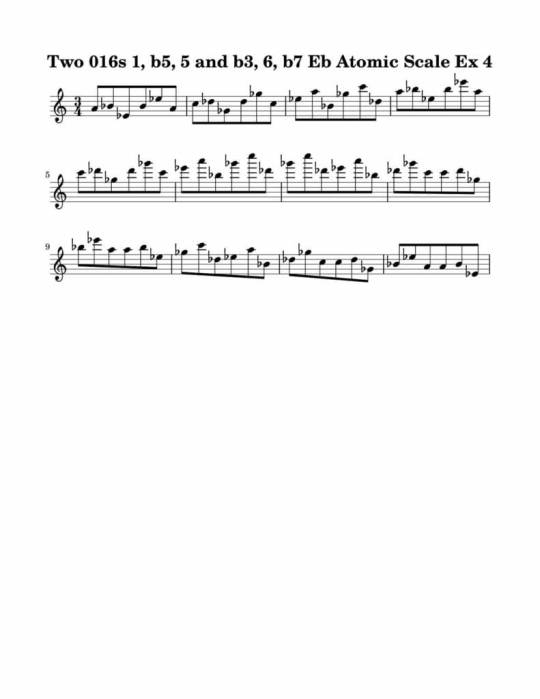
MP3 example
https://s3.amazonaws.com/media.muse-eek.com/mp3/HandMEV7/04_015_027_Degree_1_2_3_5_6_7_Atomic_Scale_Ex_4_Key_Eb.mp3
Atomic Scales 5th Rotation
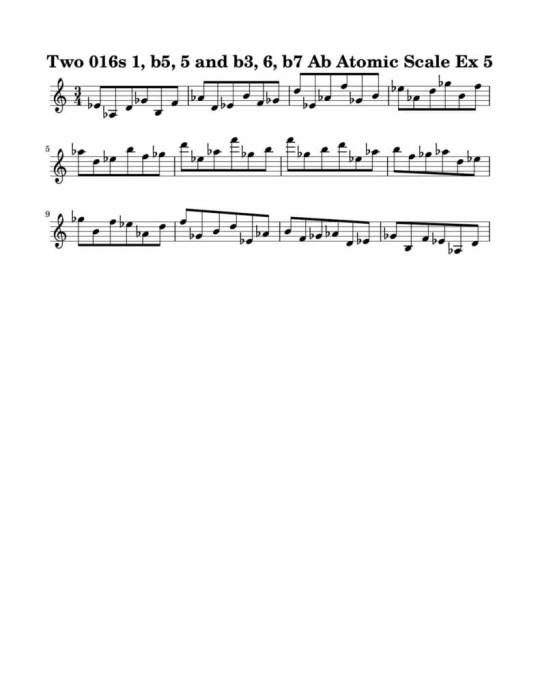
MP3 example
https://s3.amazonaws.com/media.muse-eek.com/mp3/HandMEV7/05_015_027_Degree_1_2_3_5_6_7_Atomic_Scale_Ex_5_Key_Ab.mp3
Atomic Scales 6th Rotation
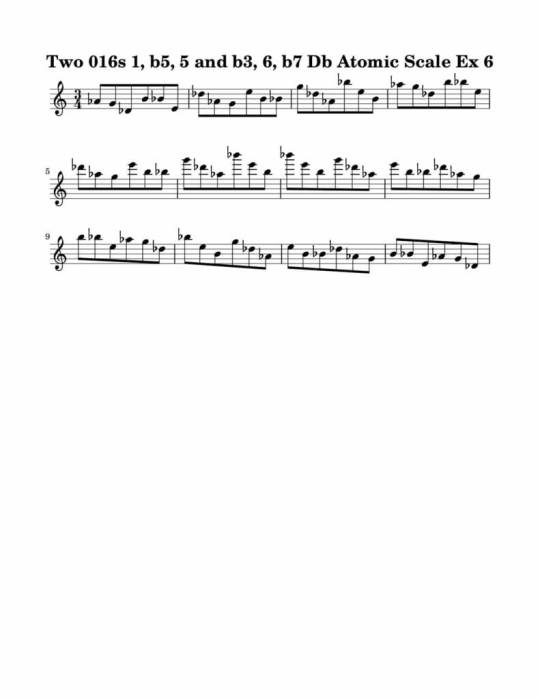
MP3 example
https://s3.amazonaws.com/media.muse-eek.com/mp3/HandMEV7/06_015_027_Degree_1_2_3_5_6_7_Atomic_Scale_Ex_6_Key_Db.mp3
TOC in the Harmonic and Melodic Equivalence V7 Course:
How to Use This Course
Harmonic/Melodic Possibilities of an 016-016 combination
Chord Possibilities of an 016-016 combination
Rotations Starting on Every Eighth Note
016-016 combination in Modal Playing
How to Think of the an 016-016 combinations used in This Course
016-016 combination daily exercise-Atomic Scales
Thinking of the an 016-016 combination as Modes
Thinking of the an 016-016 combination as One Scale
C, F#, G and Eb, A, Bb as One Scale in All Keys
Additional Practice Ideas
Get Harmonic and Melodic Equivalence V7 Today!
Add digital copy to cart - $19.99
Status: In stock, Digital book is available for immediate access.
Additional Information for Harmonic and Melodic Equivalence V7:
Digital Edition 978-1-59489-342-1
One 11 page PDF explaining exercises, 5 different types of exercises, 328 pages of exercises in PDF format in treble and bass clef
MP3's and Midi files for all exercises.
12 MP3s from Tuba MetroDrone®
What people are saying:
Hey Bruce, you were right this duel 016s is dope. I can plug this directly into my blues repertoire and it gives me a fresh new sound J. Ogland
Just wanted to let you guys know how much I'm digging this new 016-016 course. From reading the PDF this seems like a super important part of this whole series. As you mention 016 is a great substitute for a dominant chord among others. I using it both for melodic lines and chords. Really digging the new fresh sound! R. Gronick
Just wanted to drop you a note and tell you that I've picked up the Sonic Resource Guide after seeing your mention of the other 016s that can be found. What a rich resource for quickly figuring out other scales and combinations to use in music! H. Bartlett
Just wanted to let you guys know how much I appreciate this new series. It's like a crash course on contemporary improvisation. I never realize that this two triad thing was so deep and extends into non-triadic combinations. Loving this new 016 fits right into my blues playing. P. Mann
Read the full article
#HarmonicandMelodicEquivalenceV7#016-016pitchclassset#016-016rotations#016-016pitchclasssetimprovisation#contemporaryimprovisation
0 notes
Text
Correlating Simulation & Modal Test Results with Simcenter 3D
Quick Overview
youtube
A powerful way of reducing design conservatism is to validate the finite element model used to simulate its performance. Comparing the simulation model’s natural frequencies and mode shapes with those acquired in test generates confidence in the model’s ability to represent the as-built structure. This in turn allows analysts to reduce the safety factors used to compute structural margins of safety. Simcenter 3D FE Model Correlation supports both test and simulation engineers who wish to perform such a comparison, efficiently providing both visual and quantitative feedback.
Background
The Modal Assurance Criterion (MAC) is a parameter indicating the degree of consistency between a mode shape from test and another one from simulation. This parameter is a scalar value between 0 and 1: A MAC value near 1 indicates a high degree of correlation or consistency between two mode shapes.
Suppose {ΨA} and {ΨX} are two mode shapes that you want to compare: Their MAC is expressed as follows:
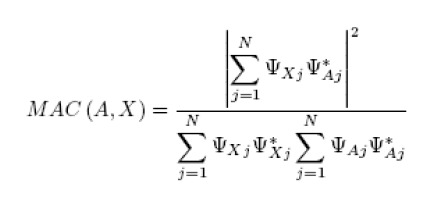
Where:
N is the number of common simulation and test mode shape components
The superscript * indicates the complex conjugate value.
There are LA x LX MAC numbers for given mode shape matrices [ΨA] and [ΨX], where LA is the number of mode shapes in [ΨA] and LX is the number of mode shapes in [ΨX]. These are presented in matrix format:
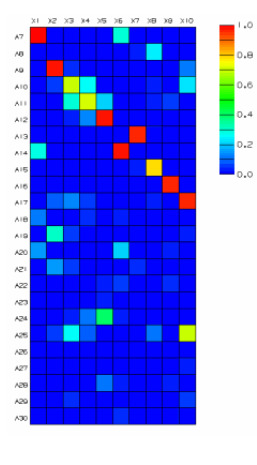
Problem Definition
We wish to compare the natural frequencies and mode shapes of an aircraft engine nacelle finite element model with the equivalent data acquired during a modal test of the actual structure:

The model and test article both represent half the nacelle.
1. Normal Modes Solution
First we create an NX Nastran normal modes solution, requesting the first 20 free-free (unconstrained) modes of the FEM. The first 6 modes describe rigid body motion, in which the structure moves without any internal strain. The next 14 modes are elastic modes, which are the ones we are interested in correlating.
In the simulation navigator, select the top-most sim node and right-click New Solution

The Solution dialog pops up. Enter a Name and as Solution Type, select Sol 103 Real Eigenvalues from the list
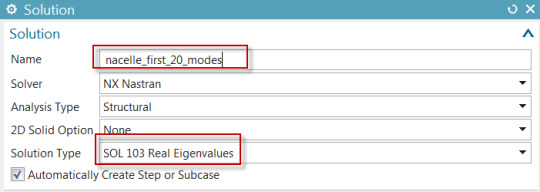
In the Case Control tab of the Solution dialog, next to Lanczos data click Create Modeling Object
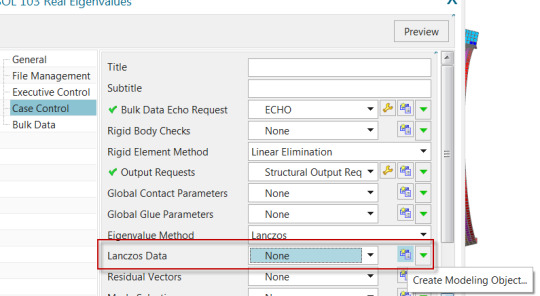
In the Real Eigenvalues Lanczos dialog, enter 20 as the Number of Desired Modes. Click OK twice.
In the sim navigator, select the solution, right-click, Solve
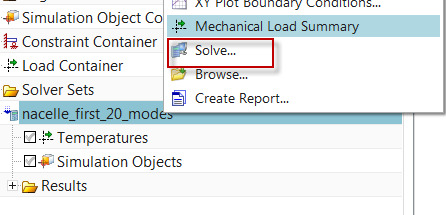
After the solution is complete, the mode shapes can be displayed from the post navigator.
2. Import Test Geometry and Results
In the Correlation tab of the Simcenter 3D ribbon, click New Test Reference Solution
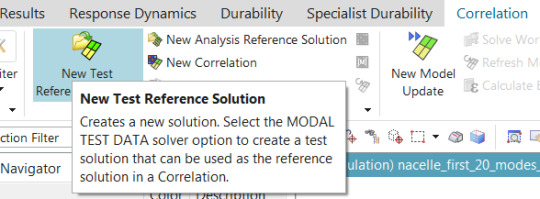
Set the Solution Type to Modal Test Data, and then select a Geometry File which contains the test geometry (test sensors, coordinate systems and traces) as well as a Modes File containing the test mode shapes and natural frequencies. In this case, the same file contains both the geometry and the mode shapes.
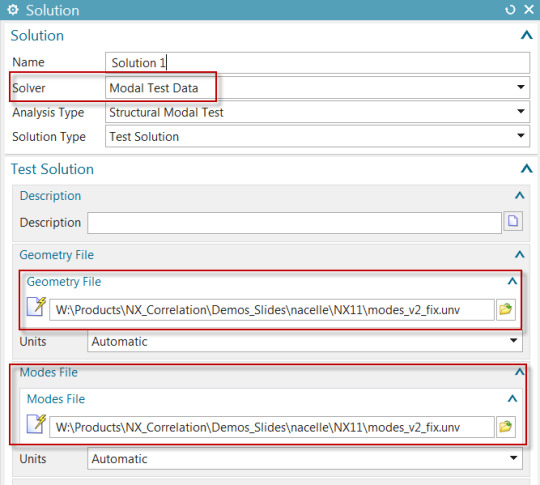
Click OK. There are now 2 solutions in the sim file.
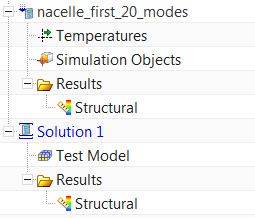
Since Solution 1 is active and points to imported geometry, the fem is now displayed as monotonic grey.
3. Align the Test Model
In the sim navigator, under Solution 1, select the Test Model node, and right-click Show Model.

You can also click Show Sensors, to see the individual sensors as triads.
It is clear that the test model and the FEM do not share the same global coordinate system. The test model will have to be aligned with the FEM in order for correlation to be possible.
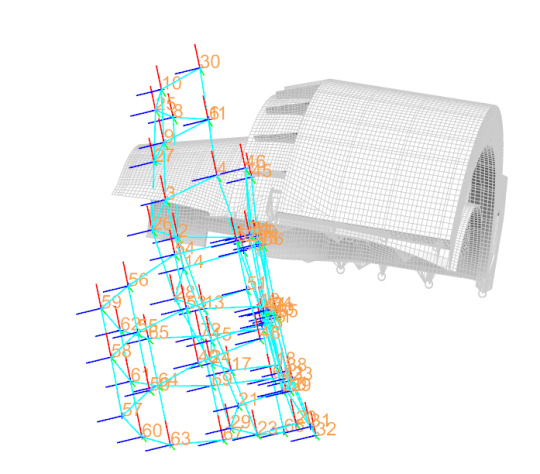
In the sim navigator, under Solution 1, select the Test Model node, and right-click Alignment. The Alignment Control dialog will appear, allowing you to choose 3 test nodes and the equivalent 3 nodes in the FEM. Checking on Preview allows you to see the cumulative effect of the pairs you have selected.

You may need to repeat this step if it is not clear which test sensors correspond to which nodes. After you have successfully performed the alignment, you may select Fine Tune Alignment to further nudge the test model by specifying discrete translations and rotations.

4. Create a Correlation
In the Correlation tab of the Simcenter 3D ribbon, click New Correlation
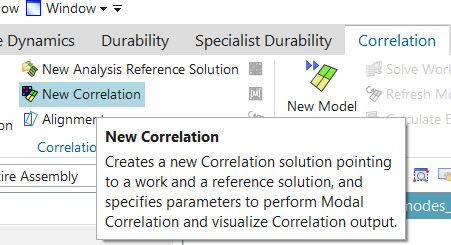
The Correlation dialog appears. Select test Solution 1 as the Reference Solution, and your normal modes solution as the Work Solution
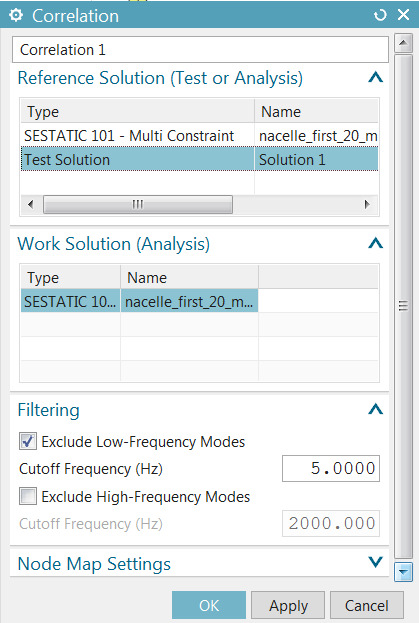
By default, low-frequency (rigid-body) modes are filtered out. In the Node Map Settings group, enter 75 mm as the matching tolerance between the test sensors and the FEM nodes. Click OK.
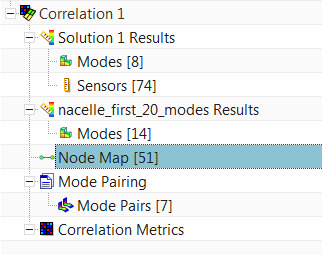
Based on the alignment that was performed, and the tolerance entered in the last step, Simcenter FE Model Correlation was able to map 51 sensors to the FE model nodes, based on proximity. If you repeat the alignment and choose different alignment node pairs, you will see a different number of paired nodes in brackets. The test and analysis mode shapes will be interrogated at these 51 locations to determine the MAC.
Next, select the Mode Pairing node under Correlation 1, right-click Edit. The default mode pairing criterion is MAC with a minimum value of 0.7: This means that test and analysis modes having the greatest MAC value above 0.7 will be paired, others will not be paired. For example, work (analysis) mode 12 is not paired to any test mode.

Other pairing methods can be selected.
Next, select the Mode Pairs (n) node under the Mode Pairing node and click the Correlation Details View bar

This pops up the Correlation Details View, which shows the test (reference) and analysis (work) frequencies, percent frequency error and MAC, for each mode pair.
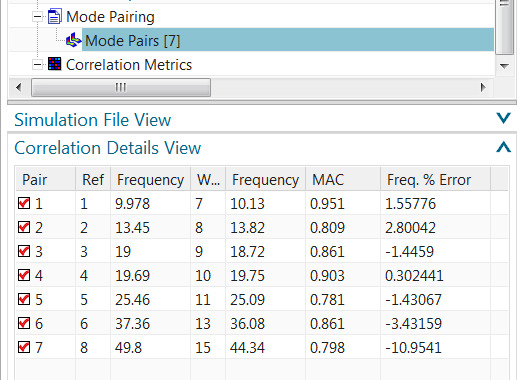
Select any mode pair row in the table, right-click Side-by-Side Animation:
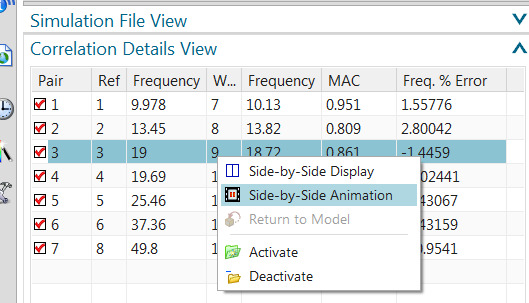
This will bring up a synchronized 2-view layout, showing the test and analysis mode shape animation

Select the Correlation Metrics node under Correlation 1, right-click Correlate. In the Correlate dialog, click Show Results Heat Map

The heat map display shows the MAC matrix

In the Correlate dialog, click Show Results Spreadsheet
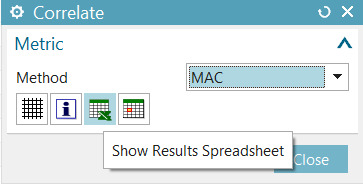
SC FE Model Correlation will send the MAC matrix to an Excel spreadsheet.

Select the Correlation Metrics node under Correlation 1, right-click Generate 1-COMAC Results.

This will show sensors at which the individual MAC components are poorest.
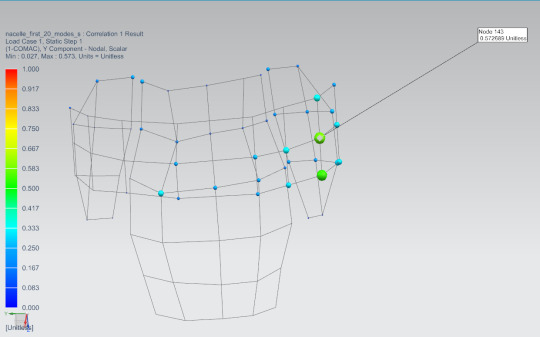
5 notes
·
View notes
Text
Starting on version 7.8.8, Mapping Tonal Harmony Pro macOS now offers two incredible and unprecedented add-ons: Upper Structures & Target Notes
These are two powerful features to study and practice tonal harmony.
Upper Structures
If you’ve been following the Upper Structure Friday’s series on the mDecks Music Youtube Channel, you probably know how complex and extensive this topic is, not to mention the effectiveness of using upper structures on top of chords in a harmonic progression.
youtube
Thanks to the music theory embedded inside Mapping Tonal Harmony Pro it was possible to create an algorithm that turns any simple chord progression into one with Upper Structures applied to every chord based on the chord/chord-scale pairing assigned to each harmonic function.
The Upper Structures add-on will include upper structure triads and quartals that work over the current progression.

The add-on is fully customizable. You can choose from six different types of upper structures: Major Triads, Minor Triads, Augmented Triads, Perfect Quartals 47 and the two Altered Quartals maj74 and maj7#4.
You can also tell Mapping Tonal Harmony Pro to use Upper Structures that contain a set amount of tension: Random, Low, Medium & High.
The Avoid tritones in m7 chords is selected by default for tonal progressions but it could be turned off for modal tunes where the tritone in a m7 chord works great.
Based on the different parameters, the app can create many different variations of the progression using upper structures. Use the NEW VARIATION button to create a new upper structure’s version of the progression.
Target Notes
Every jazz player knows that for every harmonic function there are notes that sound more inside the chords than others. Even more, some notes are responsable for giving the current chord it’s sound (i.e. 3rd or 7th)
The ability to target different notes knowing the amount of tension and the color they create over the different chords in a progression is an essential aspect when improvising or arranging.
The Target Notes Add-On will create one-note melodies over any progression using different targeting techniques. This melodies could be used to practice improvisation or create arrangements of the progression for multiple instruments (each instrument using different targeting techniques)
Following are two examples using target notes over Afternoon in Paris.
The first one is creating guide-tone lines which give the chords their basic color:
These are the 3rd (or sus4), 7th (or 6th) and altered 5th.
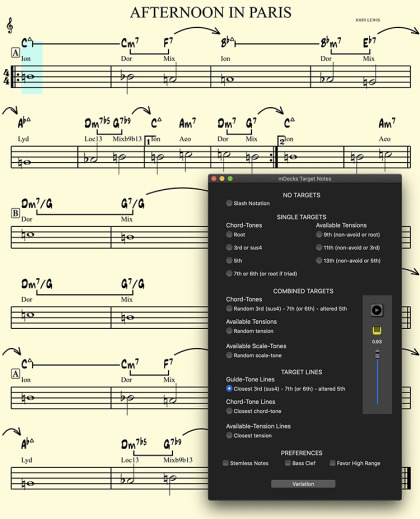
This next one just targets the 3rd of the every chord.
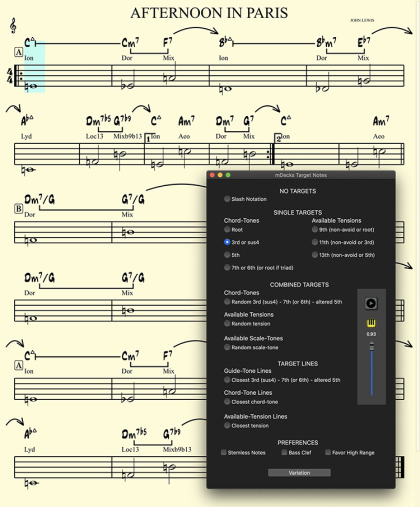
There are many possible target notes to practice, individually and in sets creating lines. This add-on offers all possible target notes that work over the progression. Avoid tensions are replaced by the closest chord-tone (i.e. if the 9th is an avoid note it will be replaced by the root)
Mapping Tonal Harmony Pro may also play the melody created so you can hear it against the play-along accompaniment.
So, there you go, two new add-ons in Mapping Tonal Harmony Pro macOS that will change the way you practice and look at music forever.
Here’s a link to the webpage for the app
Mapping Tonal Harmony Pro
Two amazing Mapping Tonal Harmony Pro ADD-ONS Starting on version 7.8.8, Mapping Tonal Harmony Pro macOS now offers two incredible and unprecedented add-ons:
0 notes
Text
Triad
Arc V Rare Pair Week - Day 1 (Applause)
Pairing: Orchestrashipping (Yuya x Reiji x Yuzu)
“You know?” He heard Yuzu ask on his right out loud while he continued to figure out how to make a particularly complicated combo to work, but he still nodded as a sign that he was listening seeing as Yuya on his left looked like he was spacing out again, although considering the way his hand was placed on top of his stomach, and the slight drool on his lip they may have to cut the activity for now in order to get lunch. “I’ve thinking for a while now... why aren’t there any rules for three-way duels?”
That seemed to pull Yuya out of his reverie and he bolted up to look at Yuzu with a questioning look.
“We do have them though? That’s what Battle Royale modality is for.” He said with a slight pout.
“Yuya, I don’t mean that!” She countered almost immediately, from the corner of his eye Reiji saw how he saw how the fan was resting on her lap ready for any… misshapen.
“But we’ve had duels between three people in those!” he said scratching his head. “It’s the same rules, the one who manages to defeat the rest wins.”
“You mean people ganging up against some poor sap and then tearing each other down afterwards?” She was now grabbing the fan with her hands.
“Uh? Well is not like it’s against the rules!” He talked back, and now Reiji was sure that his hunger was not just making him distracted but more irritable too.
“That’s exactly what I mean, that’s not a three-way duel, that’s just like a… ‘eat or be eaten’ duel!” Yuzu almost growled, coupled with her temper this situation had every chance to become very unpleasant for all the people involved.
So, he coughed a little to catch their attention.
That alone seemed to go a long way to mellow them out as they both stopped and looked up at him with a smile, and at the sight he coughed once more, this time out of necessity than for garnering attention.
“If I may…” He said making a pause waiting for them to nod and continued: “…Perhaps what Yuzu is talking about is a duel were the three participants are all against all…”
“I repeat that this is how Battle Royale works.” He said, supporting himself on his hands, looking both bored and moody.
“…If you would let me finish, Yuya.” He said. “This one would have to device rules in order to avoid any ‘ganging up’ as Yuzu said and probably need a triple board of sorts in order not to mix up the magic and trap cards zones.”
Yuzu nodded a little too enthusiastically.
“Exactly and since there wouldn’t be any teaming up against one of the duelist, the turns would also need to be structured, probably clockwise and one player wouldn’t be allowed either to directly attack or make damage to more than one duelist in order to balance things out!”
“Right!” Yuya interceded, looking happier now. “And the Trap and Spell cards would work the same! Unless they are continuous or field cards!”
“I suppose that we could call rounds every time one of the duelist has already had their own turn as well.” Reiji said, his interest truly piqued by now, already trying to decide if this would be a good mechanic to introduce in a tournament, or perhaps beta-tested first inside online dueling communities.
Then there was the sound of a stomach growling, perhaps a little too loud.
“…Maybe we can talk more about this over some snacks?” Yuya asked, looked accordingly embarrassed.
“Nu-uh, you promised Yoko-san no more junk food for lunch.” Yuzu chided and both she and Reiji crossed looks, a smile coming to her when it looked like Yuya wanted to make a case for his precious snacks.
“Besides, the last two times you and I choose where to eat, it’s only fair that Reiji chooses this time around.”
“Oh! Right,” Yuya said looking a little subdued but then he looked at him all too serious. “You better eat something solid this time too, sometimes it feels like if no one reminded you, you could for days on end without eating.”
Just as Reiji was about to give his turn to either of them he noticed Yuzu’s pout and Yuya’s eager smile, which sight were making coming to a decision difficult… it would be foolish of him to try to please only one of the two of them with their excitable tempers as they were.
And considering everything worked for the better when they reached a common agreement, Reiji liked to think of himself as no fool after all,
“If you don’t mind Nakajima taking us in the car I believe I know the perfect place, where the three of us can choose something fitting to their taste.” He said adjusting his glasses, before any of them could say anything else, Yuya jumped on his feet from their sitting spot and placed a quick peck first on Yuzu’s cheek and then on his.
.
.
.
Then rather than waiting for an answer, Yuya scratched the back of his neck, his face looking the same shade as his hair and rushed to the entrance of Yushow Duel School. Leaving both him and Yuzu to look after him, her with both a blush and a sweat drop and he assumed he had a similar expression too.
“Thank you, I know when Yuya and I start to argue about silly stuff, we can be such a handful.” She said as they walked side by side following Yuya.
“It’s quite fine really, besides I believe he will be far more agreeable once he eats at his heart’s content.” He said feeling more at ease. “I actually applaud both of your ideas, I might be able to convince the board to make a run for it.”
As an answer she perked up and dedicated him a blinding smile which had him swallowing a slightly bit.
“Mmmh, yes, and then we can start working on the three-way duel stuff too.” She said still smiling but looking a little deep in thought. “I think we work better like that right?” But then, her blush became more pronounced when she stood up and offered her hand to help him up from the floor.
He was acutely aware on the tiny squeeze she gave him before letting go and hurrying the same way Yuya had.
With that same hand he brushed his cheek, in the same spot Yuya had deposited a kiss before and knew he would have to take deep breaths before Nakajima would ask if he was coming down with a fever.
And a part of him was not all too willing to disagree.
#arc v rare pair week#arc v#orchestrashipping#my fics#read more#okay it's official#I suck at writing ot3#also very free interpretation of the prompt :P#*hides in a corner*
16 notes
·
View notes
Text
Songwriting Tasks/Challenges
Note: A lot of these relate to creating the structure/skeleton/foundation of the song, once laid down/recorded the full band/electronic arrangement/elaboration/embellishment can deviate, this is more about creating the foundation on which ideas can be comfortably built.
Choosing a scale/s and making a note of notes/possibilities beforehand may be good
1. Constructing a song from far apart intervals on Guitar (ala John Frusciante Scar Tissue, Radiohead’s Reckoner/Present Tense)
2. Constructing a song from short intervals on Guitar (ala Elliott Smith St Ides Heaven/Self Titled era)
3. Constructing a song from power chords on Guitar (ala Kurt Cobain demo recordings)
4. Constructing a song from power chords on Guitar, then increasing the harmonic complexity through a second (and/or third) guitar playing relevant intervals/expanding the power chords harmony once the movement of the progression has been established
5. Constructing a song from just melodic (monophonic) lines on Guitar, layering harmonisation
6. Constructing a song from Piano/Synth Pad Setting playing basic chords and vocal melodies
7. Constructing a song from simple chords on guitar and then building up complexity (May utilise capo for open chord voicings in different strings)
8. Constructing a song from a chord progression inside a CAGED shape
9. Constructing a song from vocal melody first, experimenting with drones and harmonisation through recording layers
10. Constructing a song from a more riff centric approach (taking cues from the riff styles of different genres)
11. Attempting to construct a song from a Wes Borland Sketching and developing approach (using recording a tool to reference back) *CONTEXTUALISE THIS WITH A LINK*
12. Constructing a song with the bassline/s as the starting point (with a metronome/basic drum beat to keep time)
13. Constructing a song from an alternate tuning on guitar
14. Constructing a song from setting chords to drum/sampler pads/Ableton drum rack
15. Constructing a song from piano melody first and then harmonising
16. Constructing a song from piano chords in C major and then altering pitch to change key
17. Constructing a song from technique centric patterns on guitar (Tapping, arpeggios etc, Tobin Abasi chord capo tapping)
18. Constructing a song from an amalgamation of weirder guitar techniques (Strumming chords then bending behind the nut, vibrato arming whole chords to slide between them, detuning and returning pitches whilst playing, using harmonics)
19. Constructing a song’s main parts on guitar with a shoegaze idiosyncratic use of effects (Weirder effects like glissando slides and pitch shifts, harmonisers, delays and the like)
20. Constructing a songs foundations utilising voice led triads (12 voicings, 4 pairings of 3 strings) Steve Banks style
21. Constructing a song creating the chord progressions on Suggester and then working them out on guitar
22. Constructing a song creating the chord progressions on Suggester and then working them out on Piano
23. Try writing a song using Hookpad to create the Foundation
24. Constructing a song from recording a jam session, analysing and deconstructing it, taking pieces from it and writing/developing it into a more structured form
25. Constructing a song from recording a jam session, editing/chopping/sampling it to construct a song, similar to the above but the end result result is derived from the original recording, like a mash up of the Miles Davis Fusion period post-production editing and electronic/hip hop sampling
26. The above approaches, but the jam/band is replaced with a ground bass and looped drum beat and improvised over and settled into motifs, approximating the style of Ataxia but followed by deconstruction and reconstruction, potentially including altering, varying, and changing the bassline under/over the ideas established, altering drums post recording is also possible
27. The above three approaches, but combining the repeating bass motif idea with a small chord framework, like a mixture of Kind Of Blue’s Modal Jazz and Ataxia
2 notes
·
View notes
Text
Recent listening—
Caroline Shaw, Partita for 8 Voices (2012)
Posed Ives: Whither music? In turn, each pioneer of the new music frontier put forth their answer. Schoenberg: dodecaphony. Stravinsky: neoclassicism. Cage: aleatory. Boulez: total serialism. Reich: minimalism. Ferneyhough: complexity. Many more tried, and many more failed. As the decades wore on, and the gurus came and went, the Neue Musik, which had begun so potent and so hopeful, grew slowly darker. Crueler. The frontier fell into disarray. The climate became, and is, cynical, ironic, and esoteric. And yet, in the cerebral thicket, see the first shape-note-sung major triad of this work’s fourth movement shining radiant, eclipsing all else surrounding. The arrival at this chord is nothing but transcendent. Not since Messiaen has such joy as this been harnessed. This chord is the leading case for the claim that triadic harmony will not—should not—be abandoned. “Resonance will exist as long as we have ears to listen to what surrounds us.” The auditory phenomenon by which we derive pleasure from certain combinations of pitches from the overtone series is no theory. It is an inevitable facet of human nature. The Partita is not merely a celebration of tonality. It is a celebration of life.
Unsuk Chin, Clarinet Concerto (2014)
Descendant of the Darmstadt school not only via Ligeti, her teacher, but also through her music’s uncompromisingly anti-melodic character and the sense of a highly advanced technical rigour behind its surface seeming chaos. In this work there’s little to detect structurally apart from the vague fast-slow-fast form the three movement demarcation appears to suggest. Zooming in it’s not quite all a continuum; it does ebb and flow and the texture grows and recedes but the problem is (and this is what makes music of this sort so fiendishly difficult to listen to) that if everything’s a blur of demisemiquavers and extended techniques there are no easily identifiable landmarks for the ear to latch onto, in turn meaning: you’re lost in a context-less whirlwind of scattered pitches and timbres. Does Chin expect you to see the crystalline logic behind all this atonal commotion? I think not for any student of Ligeti ought to’ve inherited his very niche sense of humour. So then, is feeling lost the point? It can be, if you wish. There’s much nihilistic pleasure to be derived from posing your ear in question to new music and for once, not receiving any answers.
Anton Bruckner, Symphony No. 9 in D minor (1894)
How’s Feierlich, misterioso for a tempo marking? And how’s that opening!? For once this is music truly deserving of the adjective epic. The initial horn statement lurches, leaping, leviathan from the abyss, to a scintillating C flat major triad (theoretically justifiable since the C flat resolves down and the E and G flats sustain until repose at an A flat dominant seventh) at which some monumental pair of gates opens revealing a cavernous, starry expanse. Bruckner’s music resides in this domain, and at that figure, we are within it. The sole dedicatee was God. Your personal belief is irrelevant; when you hear music of such tremendous power you are convinced of one fact: that Bruckner believed.
Arthur Honegger, Symphonie liturgique (1946)
You can tell immediately he was the most Teutonic of Les Six—but this is not to say that his music carries with it the same self-seriousness and German angst as does that of a Strauss or Mahler (which had, anyway, come out of fashion by that time). In theirs you would not find such unabashedness, such cinema as is found in these three movements: see the use of percussion, see the rampant ostinati in the first and third, see the freedom with which the second movement polyphony mingles (freedom to flirt with tonality and its opposite alike, at your heart’s discretion). And it is cinema: from the opening brass skirmishes the third mvmt. unfolds rife with Williams-esque touches—although yes, the hierarchy should really be reversed, but who knows where the syntax would take us.
Igor Stravinsky, Les noces (1922)
Sometimes I feel that this is better than the rite; that this was the peak of Stravinsky’s Russian period. It is, on the whole, less episodic, more eclectic, more economical, and, weirdly enough, more humane—notwithstanding the vocal element there’s also less of the brutal paganisms seen in e.g. the Danse sacrale. It is also more celebratory, and the general brightness of tone derives as much from the compositional approach as it does from the instrumentation. Triads are plenty rife. Modal exploration seems to remain mostly on the Ionian side. And you get more of a melody/accompaniment notion (c.f again the Danse sacrale).
0 notes
Text
Harmonic and Melodic Equivalence V6
Harmonic and Melodic Equivalence V6
Get the book for a buck with promo code:
buckbook
Harmonic and Melodic Equivalence V6
Add digital copy to cart - $19.99
Status: In stock, Digital book is available for immediate access.
Melodic Rotations Learning to Improvise More Based on the Composition
"Harmonic and Melodic Equivalence" is a series of books that will help you to develop many different musical skills simultaneously. The source materials for these books are exercises that contain two 3 note groupings, also called "trichords," that are manipulated in various ways. These exercises use many different types of harmonic and melodic ideas that can be superimposed over common chord progressions, scales and other musical situations. The exercises found in these courses are also great for singing and rhythm studies. Finally, the "Harmonic and Melodic Equivalence" course concentrates on the use of the three note pitch class sets (trichords) by pairing each trichord with another trichord with the same prime form. For instance, in this volume C, G, B and D, E, A which are an 015 and 027 pitch class set. This is a great sequence because it uses six notes that are find in any of the major modes therefore you will find a ton of useful applications which are discussed in the course.
Harmonic and Melodic Equivalence Exercises
This course is divided up into two sets of exercises written in treble and bass clef. The 1st set of exercises gets gradually harder but also more musical. Depending upon your musical skills you can start anywhere you want but for beginners I would recommend starting from the 1st exercise of the five. The 2nd set of exercises are called "Atomic Scales." These exercises are a technical exercise that really helps you to learn these ideas but also sound great as a melody right off the bat. There are 6 different types of "Atomic Scales" exercises in this course. You don't have to play every exercise in every key. But doing this will greatly increase the likelihood of you using it in real music in the future. Below is a listing of the exercises found in this course:
Closed position studies.
1st inversion studies.
2nd inversion studies.
Random combinations of closed position along with 1st and 2nd inversion.
Random combinations of closed position along with 1st and 2nd inversion with rhythmic displacement.
Atomic Scales Exercise 1
Atomic Scales Exercise 2
Atomic Scales Exercise 3
Atomic Scales Exercise 4
Atomic Scales Exercise 5
Atomic Scales Exercise 6
Explanation of 2nd Set of Exercises in Harmonic and Melodic Equivalence V6 Course
Below is an explanation for each set of the 6 different atomic scale exercises found in this course. Three octave sequences that move back and forth between the two 3 note groups are presented in six different configurations. These exercises are highly melodic and can be used verbatim as melodies when soloing. If we thought of the three notes as A,B,C then there would be six different ways to combine these notes. i.e. ABC, ACB, BAC, BCA, CAB and CBA. All exercises include MP3s as well as midi files so that you can hear and play these exercises at any tempo as well as versions in all 12 keys.
Three octave sequences that move back and forth between the two 3 note groups in the ABC sequence
Three octave sequences that move back and forth between the two 3 note groups in the ACB sequence
Three octave sequences that move back and forth between the two 3 note groups in the BAC sequence
Three octave sequences that move back and forth between the two 3 note groups in the BCA sequence
Three octave sequences that move back and forth between the two 3 note groups in the CAB sequence
Three octave sequences that move back and forth between the two 3 note groups in the CBA sequence
1st Set of Exercises in Harmonic and Melodic Equivalence V6 Course
Here are a few examples from the 1st set of exercises. A complete list of the different types of exercises can also be found below.
Closed Position Exercise

MP3 example
https://s3.amazonaws.com/media.muse-eek.com/mp3/HandMEV6/01_015_027_Degree_1_2_3_5_6_7_Closed_Position_Key_C.mp3
1st Inversion Exercise
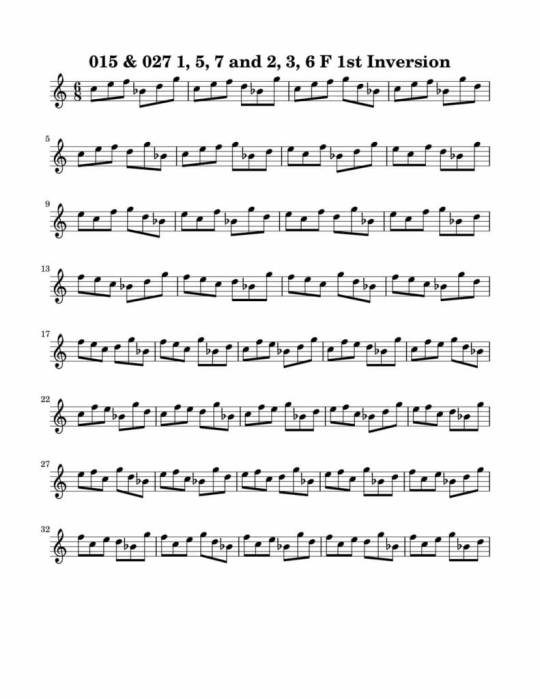
MP3 example
https://s3.amazonaws.com/media.muse-eek.com/mp3/HandMEV6/02_015_027_Degree_1_2_3_5_6_7_1st_Inversion_Key_F.mp3
2nd Inversion Exercise

MP3 example
https://s3.amazonaws.com/media.muse-eek.com/mp3/HandMEV6/03_015_027_Degree_1_2_3_5_6_7_2nd_Inversion_Key_Bb.mp3
Random combinations of closed position along with 1st and 2nd inversion.
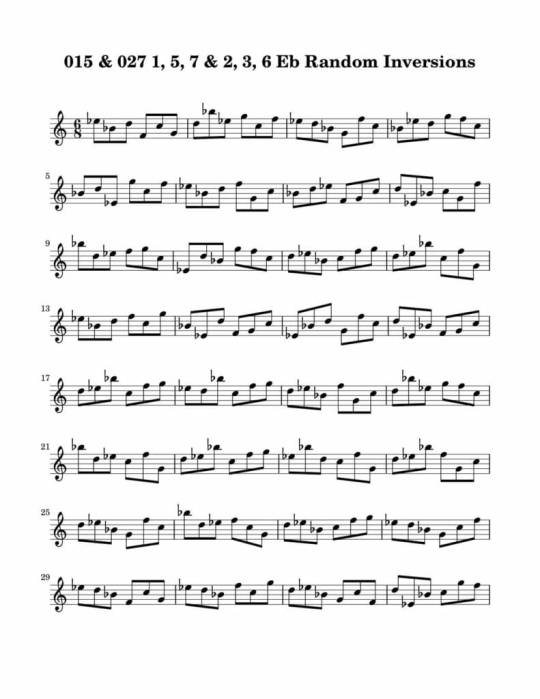
MP3 example
https://s3.amazonaws.com/media.muse-eek.com/mp3/HandMEV6/04_015_027_Degree_1_2_3_5_6_7_Random_Inversions_Key_Eb.mp3
Random combinations of closed position along with 1st and 2nd inversion and rhythm permutation
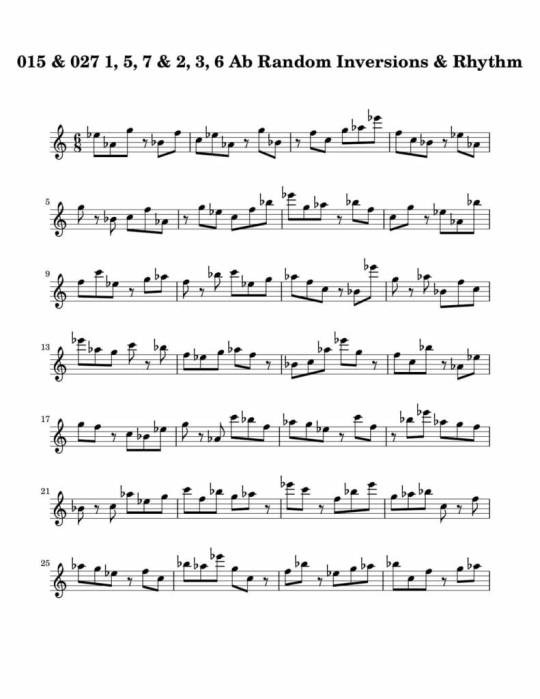
MP3 example
https://s3.amazonaws.com/media.muse-eek.com/mp3/HandMEV6/05_015_027_Degree_1_2_3_5_6_7_Random_Inv_Rhy_Key_Ab.mp3
2nd Set of Exercises in Harmonic and Melodic Equivalence V6 Course
Here are a few examples from the 2nd set of exercises.
Atomic Scales 1st Rotation
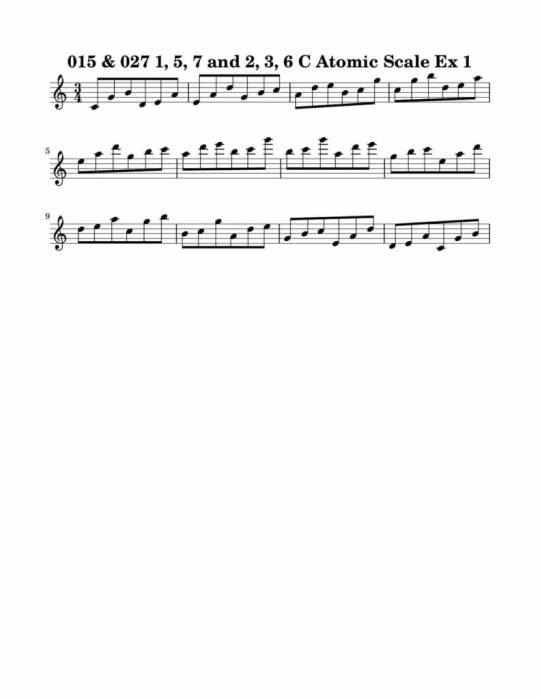
MP3 example
https://s3.amazonaws.com/media.muse-eek.com/mp3/HandMEV6/01_015_027_Degree_1_2_3_5_6_7_Atomic_Scale_Ex_1_Key_C.mp3
Atomic Scales 2nd Rotation
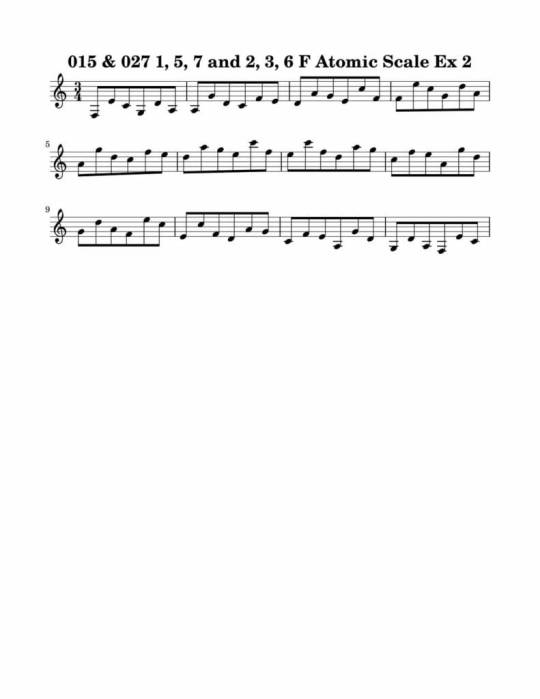
MP3 example
https://s3.amazonaws.com/media.muse-eek.com/mp3/HandMEV6/02_015_027_Degree_1_2_3_5_6_7_Atomic_Scale_Ex_2_Key_F.mp3
Atomic Scales 3rd Rotation

MP3 example
https://s3.amazonaws.com/media.muse-eek.com/mp3/HandMEV6/03_015_027_Degree_1_2_3_5_6_7_Atomic_Scale_Ex_3_Key_Bb.mp3
Atomic Scales 4th Rotation

MP3 example
https://s3.amazonaws.com/media.muse-eek.com/mp3/HandMEV6/04_015_027_Degree_1_2_3_5_6_7_Atomic_Scale_Ex_4_Key_Eb.mp3
Atomic Scales 5th Rotation
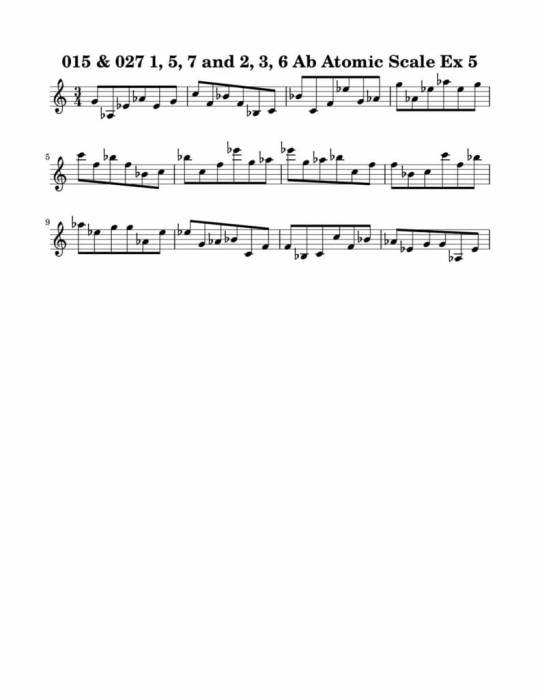
MP3 example
https://s3.amazonaws.com/media.muse-eek.com/mp3/HandMEV6/05_015_027_Degree_1_2_3_5_6_7_Atomic_Scale_Ex_5_Key_Ab.mp3
Atomic Scales 6th Rotation
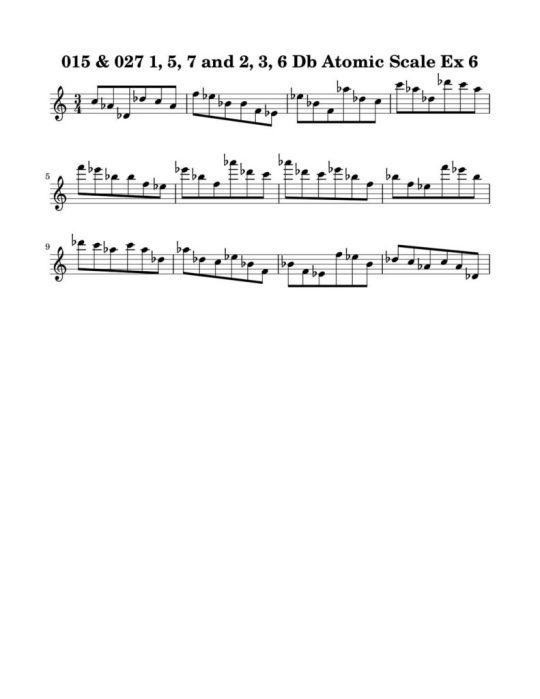
MP3 example
https://s3.amazonaws.com/media.muse-eek.com/mp3/HandMEV6/06_015_027_Degree_1_2_3_5_6_7_Atomic_Scale_Ex_6_Key_Db.mp3
TOC in the Harmonic and Melodic Equivalence V6 Course:
How to Use This Course
Harmonic/Melodic Possibilities of an 015-027 combination
Chord Possibilities of an 015-027 combination
Rotations Starting on Every Eighth Note
015-027 combination in Modal Playing
How to Think of the an 015-027 combinations used in This Course
015-027 combination daily exercise-Atomic Scales
Thinking of the an 015-027 combination as Modes
Thinking of the an 015-027 combination as One Scale
C, G, B and D, E, A as One Scale in All Keys
Additional Practice Ideas
Get Harmonic and Melodic Equivalence V6 Today!
Add digital copy to cart - $19.99
Status: In stock, Digital book is available for immediate access.
Additional Information for Harmonic and Melodic Equivalence V6:
Digital Edition 978-1-59489-341-4
One 11 page PDF explaining exercises, 5 different types of exercises, 328 pages of exercises in PDF format in treble and bass clef
MP3's and Midi files for all exercises.
12 MP3s from Tuba MetroDrone®
What people are saying:
This is such a useful book because the 015-027 can replace major and minor chords. Really appreciate you making this available because I can instantly apply it to so many situations. Thanks again!! J. Ogland
I've been struck by this 027-015 combination ever since the release of the Pitch Class Theory Courses last year. I'd highly recommend this volume as well as the Volume 19 series as a place to jump into these great books. A. Leauning
Hi Bruce, I recently picked up Volume 19A and found it very useful for applying triads to various musical situations. This 015-027 it turning out to be another book that is immediately useful for me. Such a beautiful sound that is completely fresh and new. Thanks for sharing this secret combination with us all! H. Helms
WOw this series is really opening up some new melodic and harmonic knowledge for me. Really appreciate the email correspondence and suggestions on how I can use these combinations for melodies and ear training. Y. Oldman
Read the full article
#HarmonicandMelodicEquivalenceV6#015-027pitchclasssetimprovisation#015-027rotations#12tonesoloingideas015-27
0 notes
Text
Harmonic and Melodic Equivalence V19C
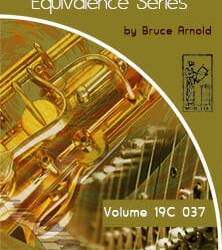
Harmonic and Melodic Equivalence V19C
Get this book for one dollar by using promo code:
buckbook
Harmonic and Melodic Equivalence V19C
Add digital copy to cart - $19.99
Status: In stock, Digital book is available for immediate access.
Melodic Rotations Learning to Improvise More Based on the Composition
"Harmonic and Melodic Equivalence" is a series of books that will help you to develop many different musical skills simultaneously. The source materials for these books are exercises that contain two 3 note groupings, also called "trichords," that are manipulated in various ways. These exercises use many different types of harmonic and melodic ideas that can be superimposed over common chord progressions, scales and other musical situations. The exercises found in these courses are also great for singing and rhythm studies. Finally, the "Harmonic and Melodic Equivalence" course concentrates on the use of the three note pitch class sets (trichords) by pairing each trichord with another trichord with the same prime form. For instance, in this volume C, Eb, G and D, F, A are both 037 pitch class sets because they both contain a minor third and a 5th within their interval structure. This is a great sequence because it uses six notes that are find in any of the major modes therefore you will find a ton of useful applications which are discussed in the course.
Harmonic and Melodic Equivalence Exercises
This course is divided up into two sets of exercises written in treble and bass clef. The 1st set of exercises gets gradually harder but also more musical. Depending upon your musical skills you can start anywhere you want but for beginners I would recommend starting from the 1st exercise of the five. The 2nd set of exercises are called "Atomic Scales." These exercises are a technical exercise that really helps you to learn these ideas but also sound great as a melody right off the bat. There are 6 different types of "Atomic Scales" exercises in this course. You don't have to play every exercise in every key. But doing this will greatly increase the likelihood of you using it in real music in the future. Below is a listing of the exercises found in this course:
Closed position studies.
1st inversion studies.
2nd inversion studies.
Random combinations of closed position along with 1st and 2nd inversion.
Random combinations of closed position along with 1st and 2nd inversion with rhythmic displacement.
Atomic Scales Exercise 1
Atomic Scales Exercise 2
Atomic Scales Exercise 3
Atomic Scales Exercise 4
Atomic Scales Exercise 5
Atomic Scales Exercise 6
Explanation of 2nd Set of Exercises in Harmonic and Melodic Equivalence V19C Course
Below is an explanation for each set of the 6 different atomic scale exercises found in this course. Three octave sequences that move back and forth between the two 3 note groups are presented in six different configurations. These exercises are highly melodic and can be used verbatim as melodies when soloing. If we thought of the three notes as A,B,C then there would be six different ways to combine these notes. i.e. ABC, ACB, BAC, BCA, CAB and CBA. All exercises include MP3s as well as midi files so that you can hear and play these exercises at any tempo as well as versions in all 12 keys.
Three octave sequences that move back and forth between the two 3 note groups in the ABC sequence
Three octave sequences that move back and forth between the two 3 note groups in the ACB sequence
Three octave sequences that move back and forth between the two 3 note groups in the BAC sequence
Three octave sequences that move back and forth between the two 3 note groups in the BCA sequence
Three octave sequences that move back and forth between the two 3 note groups in the CAB sequence
Three octave sequences that move back and forth between the two 3 note groups in the CBA sequence
1st Set of Exercises in Harmonic and Melodic Equivalence V19C Course
Here are a few examples from the 1st set of exercises. A complete list of the different types of exercises can also be found below.
Closed Position Exercise
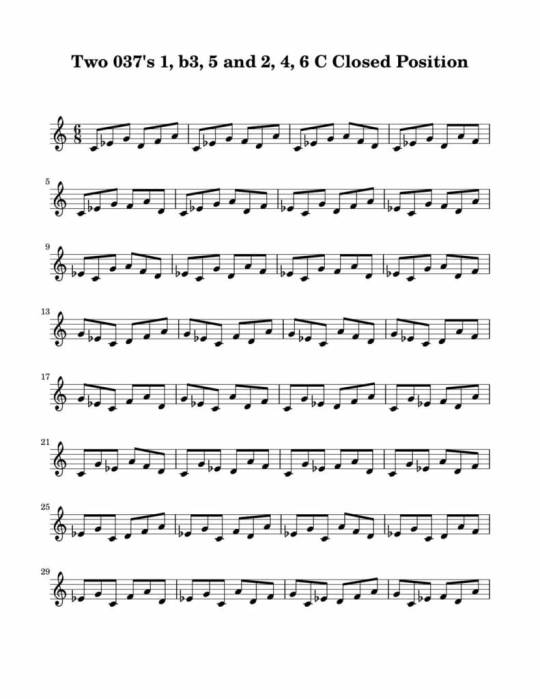
MP3 example
https://s3.amazonaws.com/media.muse-eek.com/mp3/HandME19C/01_037_Degree_1_b3_5_2_4_6_Closed_Position_Key_C.mp3
1st Inversion Exercise
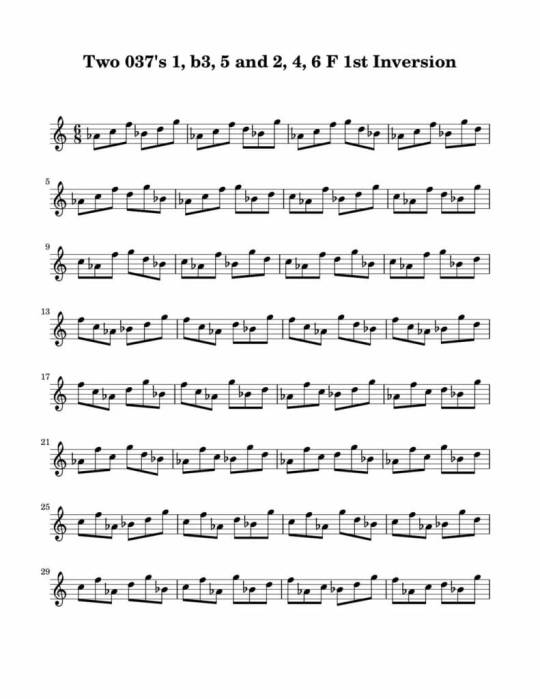
MP3 example
https://s3.amazonaws.com/media.muse-eek.com/mp3/HandME19C/02_037_Degree_1_b3_5_2_4_6_1st_Inversion_Key_F.mp3
2nd Inversion Exercise
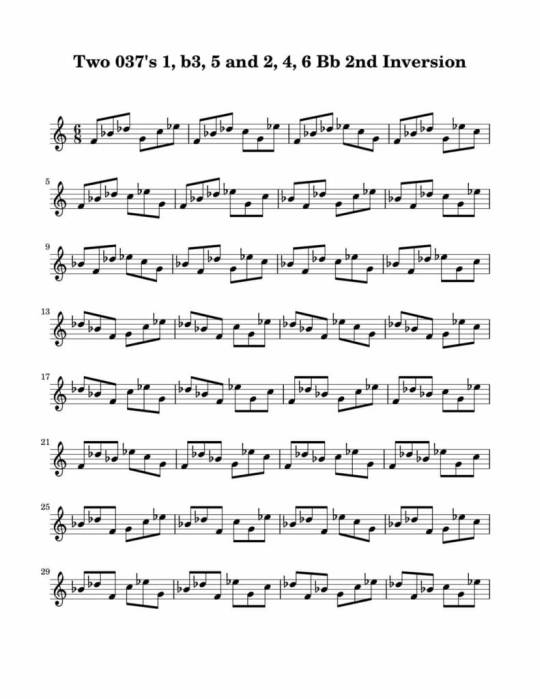
MP3 example
https://s3.amazonaws.com/media.muse-eek.com/mp3/HandME19C/03_037_Degree_1_b3_5_2_4_6_2nd_Inversion_Key_Bb.mp3
Random combinations of closed position along with 1st and 2nd inversion.

MP3 example
https://s3.amazonaws.com/media.muse-eek.com/mp3/HandME19C/04_037_Degree_1_b3_5_2_4_6_Random_Inversions_Key_Eb.mp3
Random combinations of closed position along with 1st and 2nd inversion and rhythm permutation

MP3 example
https://s3.amazonaws.com/media.muse-eek.com/mp3/HandME19C/05_037_Degree_1_3_5_2_b5_6_Random_Inv_Rhy_Key_Ab.mp3
2nd Set of Exercises in Harmonic and Melodic Equivalence V19C Course
Here are a few examples from the 2nd set of exercises.
Atomic Scales 1st Rotation
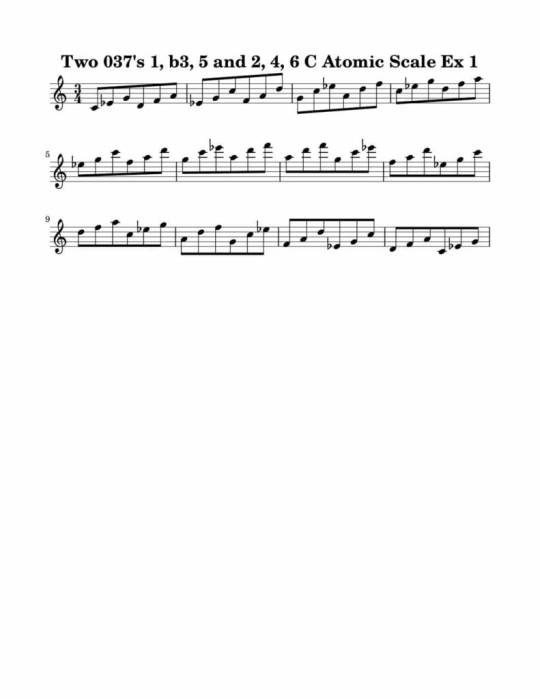
MP3 example
https://s3.amazonaws.com/media.muse-eek.com/mp3/HandME19C/01_037_Degree_1_b3_5_2_4_6_Atomic_Scale_Ex_1_Key_C.mp3
Atomic Scales 2nd Rotation
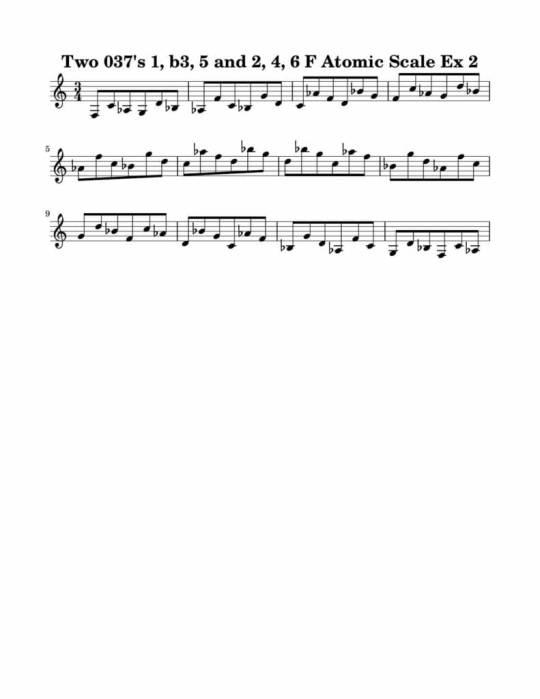
MP3 example
https://s3.amazonaws.com/media.muse-eek.com/mp3/HandME19C/02_037_Degree_1_b3_5_2_4_6_Atomic_Scale_Ex_2_Key_F.mp3
Atomic Scales 3rd Rotation
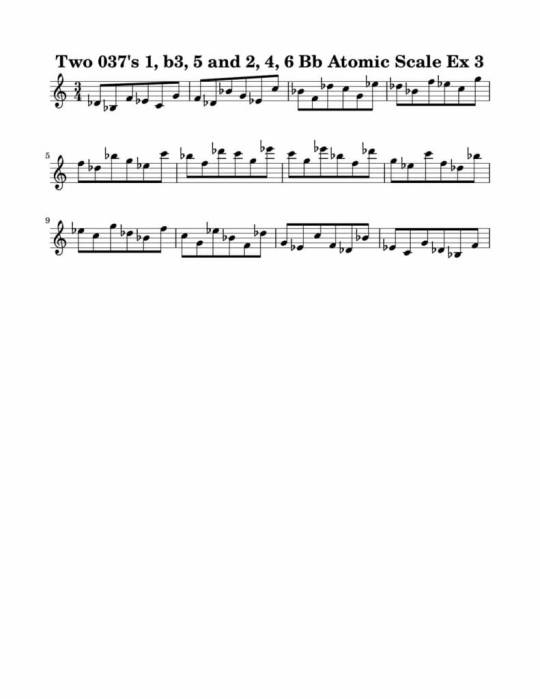
MP3 example
https://s3.amazonaws.com/media.muse-eek.com/mp3/HandME19C/03_037_Degree_1_b3_5_2_4_6_Atomic_Scale_Ex_3_Key_Bb.mp3
Atomic Scales 4th Rotation
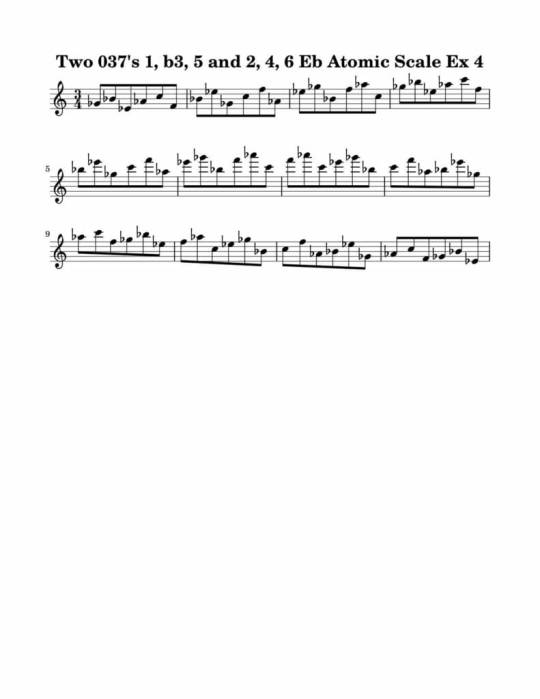
MP3 example
https://s3.amazonaws.com/media.muse-eek.com/mp3/HandME19C/04_037_Degree_1_b3_5_2_4_6_Atomic_Scale_Ex_4_Key_Eb.mp3
Atomic Scales 5th Rotation
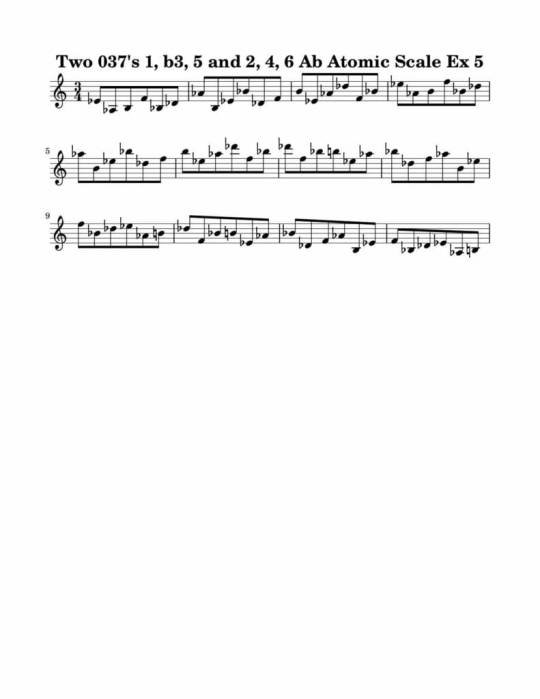
MP3 example
https://s3.amazonaws.com/media.muse-eek.com/mp3/HandME19C/05_037_Degree_1_b3_5_2_4_6_Atomic_Scale_Ex_5_Key_Ab.mp3
Atomic Scales 6th Rotation

MP3 example
https://s3.amazonaws.com/media.muse-eek.com/mp3/HandME19C/06_037_Degree_1_b3_5_2_4_6_Atomic_Scale_Ex_6_Key_Db.mp3
TOC in the Harmonic and Melodic Equivalence V19C Course:
How to Use This Course
Harmonic/Melodic Possibilities of Two 037s
Chord Possibilities of Two 037s
Rotations Starting on Every Eighth Note
Two 037's in Modal Playing
How to Think of the 037s used in this course
037 Daily Exercise-Atomic Scales
Thinking of the Trichords as Modes
Thinking of the Trichords as One Scale
C, Eb, G and D, F, A as One Scale in All Keys
Additional Practice Ideas
Get Harmonic and Melodic Equivalence V19C Today!
Add digital copy to cart - $19.99
Status: In stock, Digital book is available for immediate access.
Additional Information for Harmonic and Melodic Equivalence V19C:
Digital Edition 978-1-59489-339-1
One 11 page PDF explaining exercises, 5 different types of exercises, 328 pages of exercises in PDF format in treble and bass clef
MP3's and Midi files for all exercises.
12 MP3s from Tuba MetroDrone®
What people are saying:
Hey Muse Eek, thanks for including my steady stream of comments on this series. I find the "19" series to be the most helpful in my develop of this idea. Very easy to hear and of course many of these triad pairs show up in common scales that I use so that makes using them easy. J. Ogland
Just wanted to reach out and tell you how much I appreciate you making these books available. I mostly use them for ear training to build my key retention. As you pointed out the Key Retention Builder book is great for building key retention but also singing these exercises shows that different types of melodies create their own set of issues. H. Darwin
Hey Guys really digging this new two minor triad course! Gives me a whole new way to use simple triads to create a very unique and useful sound. A. Gary
Hey Bruce thanks for recommending the singing of these exercises to improve key retention. I'm finding that about half of the 12 keys are totally kicking by behind. I'm really starting to hear that certain melodic combinations pull my ear out of a key center and this is making me very aware of a weak point in my aural skills B. Bolton
Read the full article
#DoubleMambo#improvisation#pitchclassset#12tone#rotations#CharlieBanacos#pitchclasssetsoloingideas#HarmonicandMelodicEquivalenceV19C
0 notes
Text
Harmonic and Melodic Equivalence V4

Harmonic and Melodic Equivalence V4
Get book for one dollar with promo code:
buckbook
Harmonic and Melodic Equivalence V4
Add digital copy to cart - $19.99
Status: In stock, Digital book is available for immediate access.
Melodic Rotations Learning to Improvise More Based on the Composition
"Harmonic and Melodic Equivalence" is a series of books that will help you to develop many different musical skills simultaneously. The source materials for these books are exercises that contain two 3 note groupings, also called "trichords," that are manipulated in various ways. These exercises use many different types of harmonic and melodic ideas that can be superimposed over common chord progressions, scales and other musical situations. The exercises found in these courses are also great for singing and rhythm studies. Finally, the "Harmonic and Melodic Equivalence" course concentrates on the use of the three note pitch class sets (trichords) by pairing each trichord with another trichord with the same prime form. For instance, in this volume C, Db, E and F#, G, Bb are both 014 pitch class sets because they both contain a 1/2 step and a Major 3rd within their interval structure. This is a great sequence because it uses six notes that are find in any of the major modes therefore you will find a ton of useful applications which are discussed in the course.
Harmonic and Melodic Equivalence Exercises
This course is divided up into two sets of exercises written in treble and bass clef. The 1st set of exercises gets gradually harder but also more musical. Depending upon your musical skills you can start anywhere you want but for beginners I would recommend starting from the 1st exercise of the five. The 2nd set of exercises are called "Atomic Scales." These exercises are a technical exercise that really helps you to learn these ideas but also sound great as a melody right off the bat. There are 6 different types of "Atomic Scales" exercises in this course. You don't have to play every exercise in every key. But doing this will greatly increase the likelihood of you using it in real music in the future. Below is a listing of the exercises found in this course:
Closed position studies.
1st inversion studies.
2nd inversion studies.
Random combinations of closed position along with 1st and 2nd inversion.
Random combinations of closed position along with 1st and 2nd inversion with rhythmic displacement.
Atomic Scales Exercise 1
Atomic Scales Exercise 2
Atomic Scales Exercise 3
Atomic Scales Exercise 4
Atomic Scales Exercise 5
Atomic Scales Exercise 6
Explanation of 2nd Set of Exercises in Harmonic and Melodic Equivalence V4 Course
Below is an explanation for each set of the 6 different atomic scale exercises found in this course. Three octave sequences that move back and forth between the two 3 note groups are presented in six different configurations. These exercises are highly melodic and can be used verbatim as melodies when soloing. If we thought of the three notes as A,B,C then there would be six different ways to combine these notes. i.e. ABC, ACB, BAC, BCA, CAB and CBA. All exercises include MP3s as well as midi files so that you can hear and play these exercises at any tempo as well as versions in all 12 keys.
Three octave sequences that move back and forth between the two 3 note groups in the ABC sequence
Three octave sequences that move back and forth between the two 3 note groups in the ACB sequence
Three octave sequences that move back and forth between the two 3 note groups in the BAC sequence
Three octave sequences that move back and forth between the two 3 note groups in the BCA sequence
Three octave sequences that move back and forth between the two 3 note groups in the CAB sequence
Three octave sequences that move back and forth between the two 3 note groups in the CBA sequence
1st Set of Exercises in Harmonic and Melodic Equivalence V4 Course
Here are a few examples from the 1st set of exercises. A complete list of the different types of exercises can also be found below.
Closed Position Exercise
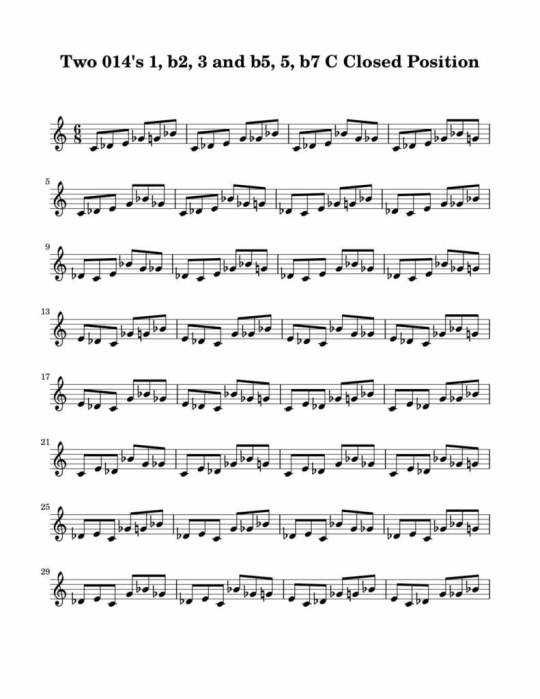
MP3 example
https://s3.amazonaws.com/media.muse-eek.com/mp3/HandMEV4/01_014_Degree_1_b2_3_b5_5_b7_Closed_Position_Key_C.mp3
1st Inversion Exercise
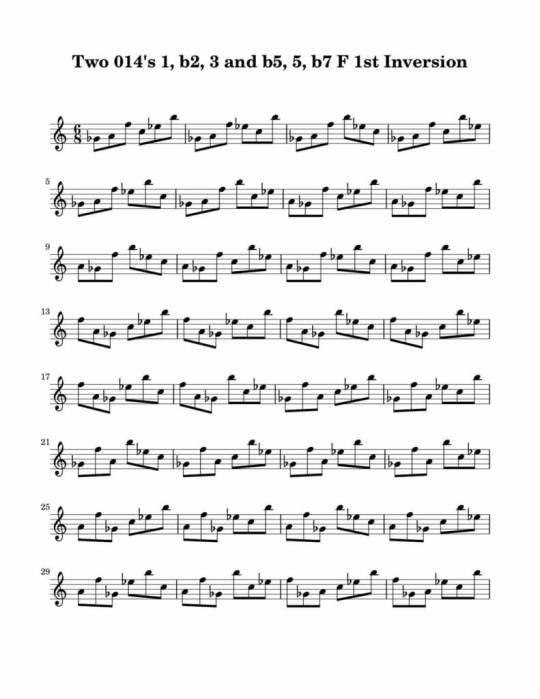
MP3 example
https://s3.amazonaws.com/media.muse-eek.com/mp3/HandMEV4/02_014_Degree_1_b2_3_b5_5_b7_1st_Inversion_Key_F.mp3
2nd Inversion Exercise

MP3 example
https://s3.amazonaws.com/media.muse-eek.com/mp3/HandMEV4/03_014_Degree_1_b2_3_b5_5_b7_2nd_Inversion_Key_Bb.mp3
Random combinations of closed position along with 1st and 2nd inversion.

MP3 example
https://s3.amazonaws.com/media.muse-eek.com/mp3/HandMEV4/04_014_Degree_1_b2_3_b5_5_b7_Random_Inversions_Key_Eb.mp3
Random combinations of closed position along with 1st and 2nd inversion and rhythm permutation
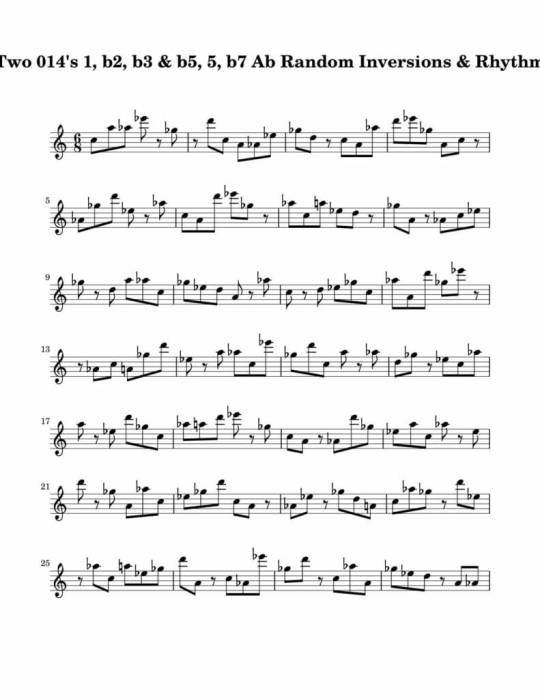
MP3 example
https://s3.amazonaws.com/media.muse-eek.com/mp3/HandMEV4/05_014_Degree_1_b2_b3_b5_5_b7_Random_Inv_Rhy_Key_Ab.mp3
2nd Set of Exercises in Harmonic and Melodic Equivalence V4 Course
Here are a few examples from the 2nd set of exercises.
Atomic Scales 1st Rotation
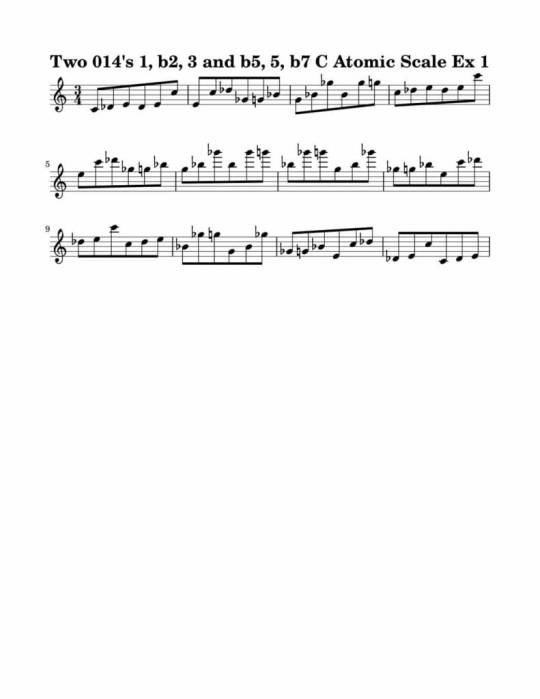
MP3 example
https://s3.amazonaws.com/media.muse-eek.com/mp3/HandMEV4/01_014_Degree_1_b2_3_b5_5_b7_Atomic_Scale_Ex_1_Key_C.mp3
Atomic Scales 2nd Rotation
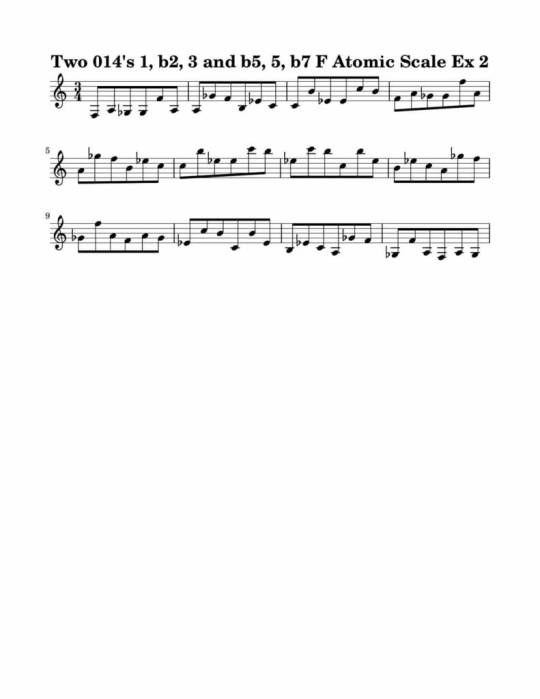
MP3 example
https://s3.amazonaws.com/media.muse-eek.com/mp3/HandMEV4/02_014_Degree_1_b2_3_b5_5_b7_Atomic_Scale_Ex_2_Key_F.mp3
Atomic Scales 3rd Rotation
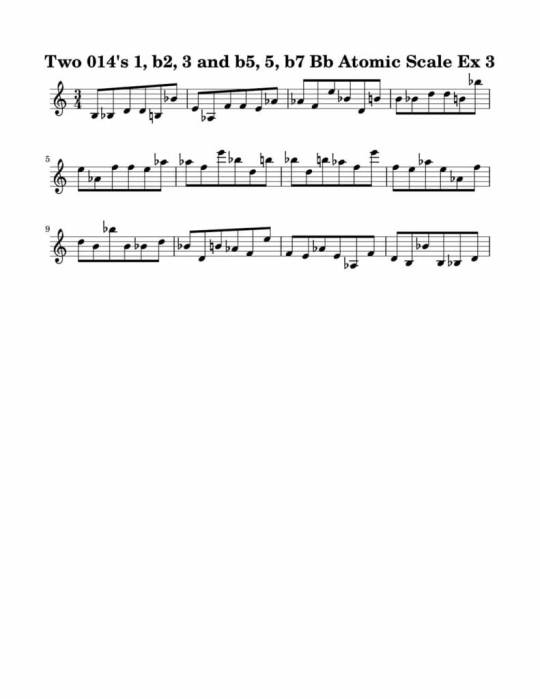
MP3 example
https://s3.amazonaws.com/media.muse-eek.com/mp3/HandMEV4/03_014_Degree_1_b2_3_b5_5_b7_Atomic_Scale_Ex_3_Key_Bb.mp3
Atomic Scales 4th Rotation
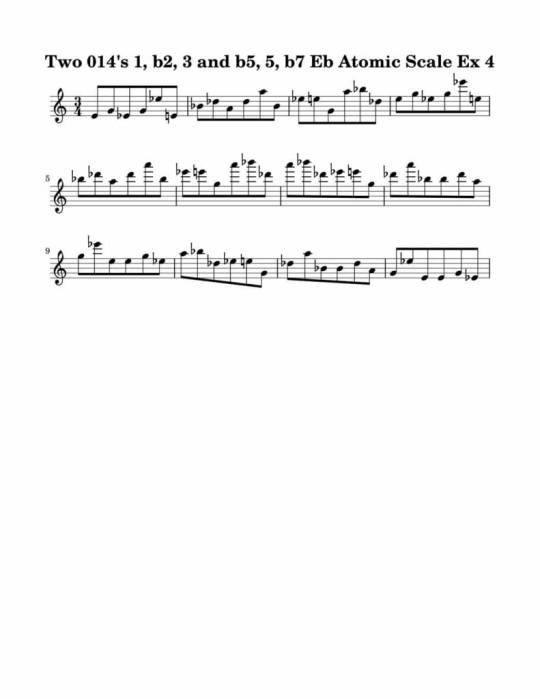
MP3 example
https://s3.amazonaws.com/media.muse-eek.com/mp3/HandMEV4/04_014_Degree_1_b2_3_b5_5_b7_Atomic_Scale_Ex_4_Key_Eb.mp3
Atomic Scales 5th Rotation

MP3 example
https://s3.amazonaws.com/media.muse-eek.com/mp3/HandMEV4/05_014_Degree_1_b2_3_b5_5_b7_Atomic_Scale_Ex_5_Key_Ab.mp3
Atomic Scales 6th Rotation
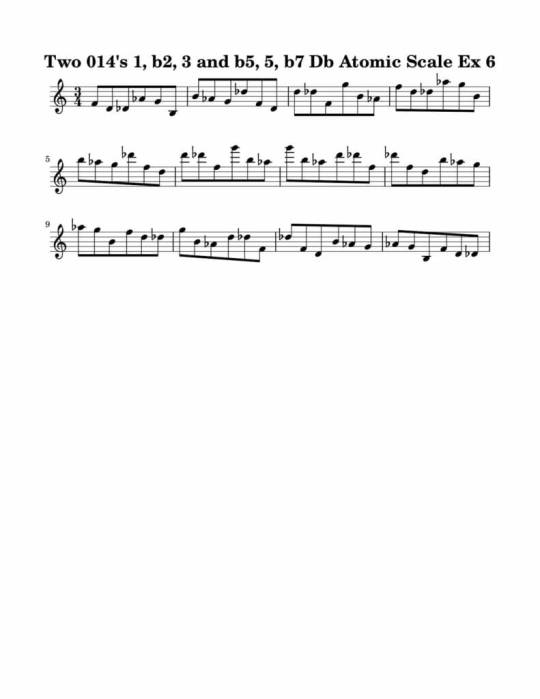
MP3 example
https://s3.amazonaws.com/media.muse-eek.com/mp3/HandMEV4/06_014_Degree_1_b2_3_b5_5_b7_Atomic_Scale_Ex_6_Key_Db.mp3
TOC in the Harmonic and Melodic Equivalence V4 Course:
How to Use This Course
Harmonic/Melodic Possibilities of Two 014s
Chord Possibilities of Two 014s
Rotations Starting on Every Eighth Note
Two 014s in Modal Playing
How to Think of the 014s Used in This Course
014 Daily Exercise-Atomic Scales
Thinking of the Trichords as Modes
Thinking of the Trichords as One Scale
C, Db, E and F#, G, Bb as One Scale in All Keys
Additional Practice Ideas
Get Harmonic and Melodic Equivalence V4 Today!
Add digital copy to cart - $19.99
Status: In stock, Digital book is available for immediate access.
Additional Information for Harmonic and Melodic Equivalence V4:
Digital Edition 978-1-59489-337-7
One 11 page PDF explaining exercises, 5 different types of exercises, 328 pages of exercises in PDF format in treble and bass clef
MP3's and Midi files for all exercises.
12 MP3s from Tuba MetroDrone®
What people are saying:
Hey Muse Eek the Harmonic and Melodic Equivalence V2 and this volume has some really cool ideas for altering a 1/2-whole octatonic scale. I'm really enjoying these new sounds Thanks! J. Ogland
Just wanted to drop you a note to say how much I appreciate this new series of books. The atomic scales is such an interesting way to make a melody. They all sound so refreshing. A. Andrews
Bruce I just wanted to thank you for the new series Harmonic and Melodic Equivalence. I think I'm like you when you mentioned that these two triad ideas can really get under your skin. I'm really loving this concept! J. Reynolds
Just wanted to say that these 014s are my favorite. I'm a big Monk fan and this sound really hits the mark!! P. Manny
Read the full article
0 notes
Text
Harmonic and Melodic Equivalence V19B
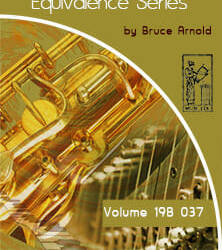
Harmonic and Melodic Equivalence V19B
Get it for one dollar with promo code:
buckbook
Harmonic and Melodic Equivalence V19B
Add digital copy to cart - $19.99
Status: In stock, Digital book is available for immediate access.
Melodic Rotations Learning to Improvise More Based on the Composition
"Harmonic and Melodic Equivalence" is a series of books that will help you to develop many different musical skills simultaneously. The source materials for these books are exercises that contain two 3 note groupings, also called "trichords," that are manipulated in various ways. These exercises use many different types of harmonic and melodic ideas that can be superimposed over common chord progressions, scales and other musical situations. The exercises found in these courses are also great for singing and rhythm studies. Finally, the "Harmonic and Melodic Equivalence" course concentrates on the use of the three note pitch class sets (trichords) by pairing each trichord with another trichord with the same prime form. For instance, in this volume C, E, G and D, F#, A are both 037 pitch class sets because they both contain a major third and a 5th within their interval structure. This is a great sequence because it uses six notes that are find in any of the major modes therefore you will find a ton of useful applications which are discussed in the course.
Harmonic and Melodic Equivalence Exercises
This course is divided up into two sets of exercises written in treble and bass clef. The 1st set of exercises gets gradually harder but also more musical. Depending upon your musical skills you can start anywhere you want but for beginners I would recommend starting from the 1st exercise of the five. The 2nd set of exercises are called "Atomic Scales." These exercises are a technical exercise that really helps you to learn these ideas but also sound great as a melody right off the bat. There are 6 different types of "Atomic Scales" exercises in this course. You don't have to play every exercise in every key. But doing this will greatly increase the likelihood of you using it in real music in the future. Below is a listing of the exercises found in this course:
Closed position studies.
1st inversion studies.
2nd inversion studies.
Random combinations of closed position along with 1st and 2nd inversion.
Random combinations of closed position along with 1st and 2nd inversion with rhythmic displacement.
Atomic Scales Exercise 1
Atomic Scales Exercise 2
Atomic Scales Exercise 3
Atomic Scales Exercise 4
Atomic Scales Exercise 5
Atomic Scales Exercise 6
Explanation of 2nd Set of Exercises in Harmonic and Melodic Equivalence V19B Course
Below is an explanation for each set of the 6 different atomic scale exercises found in this course. Three octave sequences that move back and forth between the two 3 note groups are presented in six different configurations. These exercises are highly melodic and can be used verbatim as melodies when soloing. If we thought of the three notes as A,B,C then there would be six different ways to combine these notes. i.e. ABC, ACB, BAC, BCA, CAB and CBA. All exercises include MP3s as well as midi files so that you can hear and play these exercises at any tempo as well as versions in all 12 keys.
Three octave sequences that move back and forth between the two 3 note groups in the ABC sequence
Three octave sequences that move back and forth between the two 3 note groups in the ACB sequence
Three octave sequences that move back and forth between the two 3 note groups in the BAC sequence
Three octave sequences that move back and forth between the two 3 note groups in the BCA sequence
Three octave sequences that move back and forth between the two 3 note groups in the CAB sequence
Three octave sequences that move back and forth between the two 3 note groups in the CBA sequence
1st Set of Exercises in Harmonic and Melodic Equivalence V19B Course
Here are a few examples from the 1st set of exercises. A complete list of the different types of exercises can also be found below.
Closed Position Exercise

MP3 example
https://s3.amazonaws.com/media.muse-eek.com/mp3/HandMEV19B/01_037_Degree_1_3_5_2_b5_6_Closed_Position_Key_C.mp3
1st Inversion Exercise
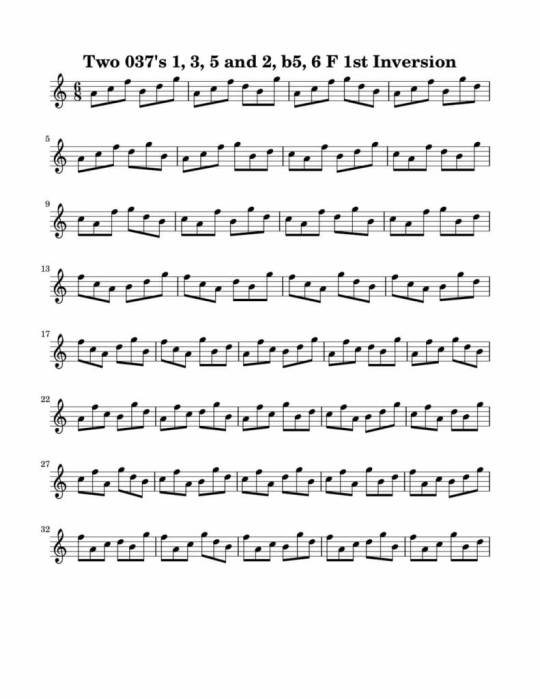
MP3 example
https://s3.amazonaws.com/media.muse-eek.com/mp3/HandMEV19B/02_037_Degree_1_3_5_2_b5_6_1st_Inversion_Key_F.mp3
2nd Inversion Exercise
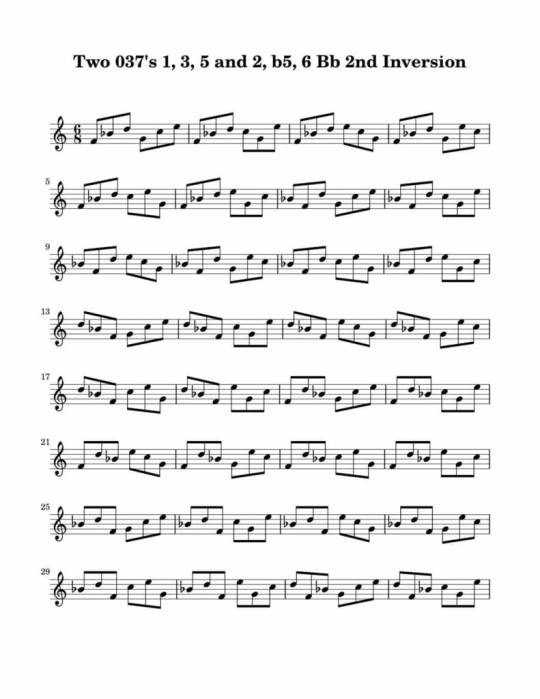
MP3 example
https://s3.amazonaws.com/media.muse-eek.com/mp3/HandMEV19B/03_037_Degree_1_3_5_2_b5_6_2nd_Inversion_Key_Bb.mp3
Random combinations of closed position along with 1st and 2nd inversion.

MP3 example
https://s3.amazonaws.com/media.muse-eek.com/mp3/HandMEV19B/04_037_Degree_1_3_5_2_b5_6_Random_Inversions_Key_Eb.mp3
Random combinations of closed position along with 1st and 2nd inversion and rhythm permutation

MP3 example
https://s3.amazonaws.com/media.muse-eek.com/mp3/HandMEV19B/05_037_Degree_1_3_5_2_b5_6_Random_Inv_Rhy_Key_Ab.mp3
2nd Set of Exercises in Harmonic and Melodic Equivalence V19B Course
Here are a few examples from the 2nd set of exercises.
Atomic Scales 1st Rotation
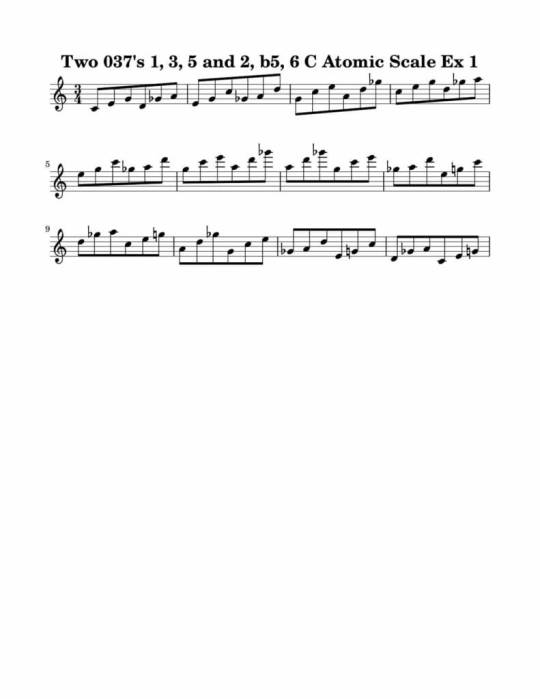
MP3 example
https://s3.amazonaws.com/media.muse-eek.com/mp3/HandMEV19B/01_037_Degree_1_3_5_2_b5_6_Atomic_Scale_Ex_1_Key_C.mp3
Atomic Scales 2nd Rotation
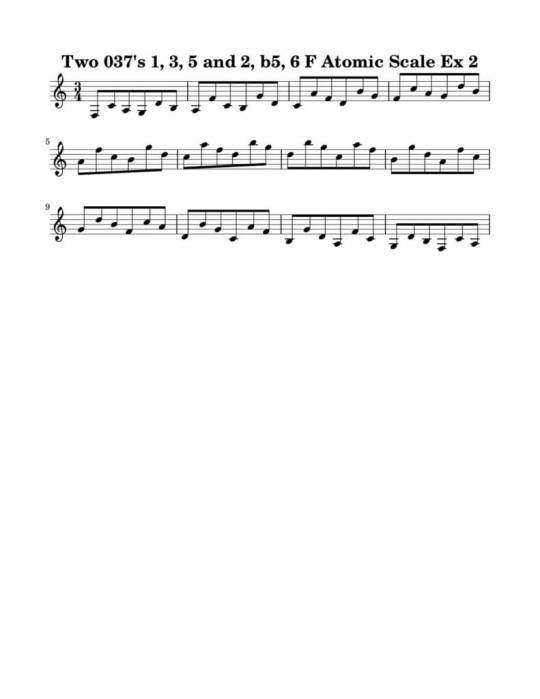
MP3 example
https://s3.amazonaws.com/media.muse-eek.com/mp3/HandMEV19B/02_037_Degree_1_3_5_2_b5_6_Atomic_Scale_Ex_2_Key_F.mp3
Atomic Scales 3rd Rotation
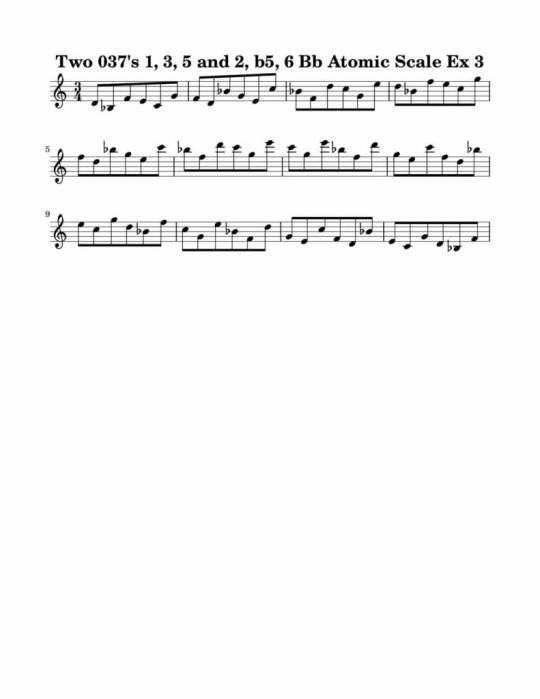
MP3 example
https://s3.amazonaws.com/media.muse-eek.com/mp3/HandMEV19B/03_037_Degree_1_3_5_2_b5_6_Atomic_Scale_Ex_3_Key_Bb.mp3
Atomic Scales 4th Rotation

MP3 example
https://s3.amazonaws.com/media.muse-eek.com/mp3/HandMEV19B/04_037_Degree_1_3_5_2_b5_6_Atomic_Scale_Ex_4_Key_Eb.mp3
Atomic Scales 5th Rotation
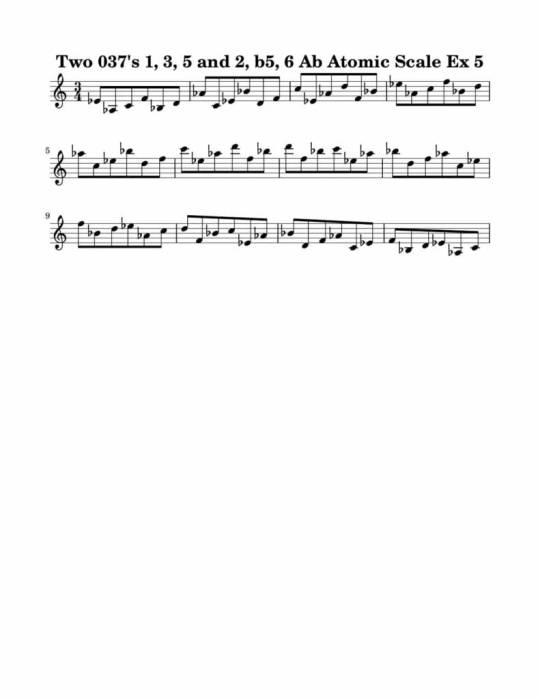
MP3 example
https://s3.amazonaws.com/media.muse-eek.com/mp3/HandMEV19B/05_037_Degree_1_3_5_2_b5_6_Atomic_Scale_Ex_5_Key_Ab.mp3
Atomic Scales 6th Rotation

MP3 example
https://s3.amazonaws.com/media.muse-eek.com/mp3/HandMEV19B/06_037_Degree_1_3_5_2_b5_6_Atomic_Scale_Ex_6_Key_Db.mp3
TOC in the Harmonic and Melodic Equivalence V19B Course:
How to Use This Course
Harmonic/Melodic Possibilities of Two 037s
Chord Possibilities of Two 037s
Rotations Starting on Every Eighth Note
Two 037's in Modal Playing
How to Think of the 037s Used in This Course
037 Daily Exercise-Atomic Scales
Thinking of the Trichords as Modes
Thinking of the Trichords as One Scale
C, E, G and D, F#, A as One Scale in All Keys
Additional Practice Ideas
Get Harmonic and Melodic Equivalence V19B Today!
Add digital copy to cart - $19.99
Status: In stock, Digital book is available for immediate access.
Additional Information for Harmonic and Melodic Equivalence V19B:
Digital Edition 978-1-59489-338-4
One 11 page PDF explaining exercises, 5 different types of exercises, 328 pages of exercises in PDF format in treble and bass clef
MP3's and Midi files for all exercises.
12 MP3s from Tuba MetroDrone®
What people are saying:
Wow the original Charlie Banacos "Double Mambo" concept. I see why Mr. Arnold got so excited about this sound when he was introduced to it. Super hip and can be used is so many ways! J. Ogland
Thanks Bruce, this is a must own volume in the series. Such a strong and unique sound with the two major triads. If it's good enough for McCoy Tyner then it's good enough for me! K. Edwards
Bruce I just wanted to give a shout out on this new Harmonic and Melodic Equivalence V19B course. What a cool sound these two triads make! Appreciate all the work you put into it. E. Greig
Hey Muse Eek just wanted to give you my 2 cents on this new course. First the "Atomic Scales" exercise is really helping me get these ideas under my fingers. Also thanks for pointing out how Tyner's "Passion Dance" is totally derived from this sound. Listen to that track has been very inspiring. J. Samuels
Read the full article
#DoubleMambo#improvisation#pitchclassset#12tone#McCoyTyner#rotations#soloingideas#HarmonicandMelodicEquivalenceV19B#CharlieBanacos#McCoyTynerPassionDance
0 notes
Text
Harmonic and Melodic Equivalence V19A
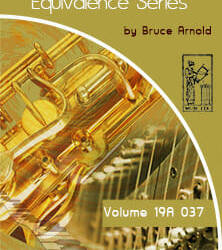
Harmonic and Melodic Equivalence V19A
Buy now for 1.00 USD
Promo code: buckbook
Harmonic and Melodic Equivalence V19A
Add digital copy to cart - $19.99
Status: In stock, Digital book is available for immediate access.
Melodic Rotations Learning to Improvise More Based on the Composition
"Harmonic and Melodic Equivalence" is a series of books that will help you to develop many different musical skills simultaneously. The source materials for these books are exercises that contain two 3 note groupings, also called "trichords," that are manipulated in various ways. These exercises use many different types of harmonic and melodic ideas that can be superimposed over common chord progressions, scales and other musical situations. The exercises found in these courses are also great for singing and rhythm studies. Finally, the "Harmonic and Melodic Equivalence" course concentrates on the use of the three note pitch class sets (trichords) by pairing each trichord with another trichord with the same prime form. For instance, in this volume C, Db, Eb and F#, G, A are both 013 pitch class sets because they both contain a 1/2 step and a minor 3rd within their interval structure. This is a great sequence because it uses six notes from a symmetrical diminished scale therefore you will find a ton of useful applications which are discussed in the course.
Harmonic and Melodic Equivalence Exercises
This course is divided up into two sets of exercises written in treble and bass clef. The 1st set of exercises gets gradually harder but also more musical. Depending upon your musical skills you can start anywhere you want but for beginners I would recommend starting from the 1st exercise of the five. The 2nd set of exercises are called "Atomic Scales." These exercises are a technical exercise that really helps you to learn these ideas but also sound great as a melody right off the bat. There are 6 different types of "Atomic Scales" exercises in this course. You don't have to play every exercise in every key. But doing this will greatly increase the likelihood of you using it in real music in the future. Below is a listing of the exercises found in this course:
Closed position studies.
1st inversion studies.
2nd inversion studies.
Random combinations of closed position along with 1st and 2nd inversion.
Random combinations of closed position along with 1st and 2nd inversion with rhythmic displacement.
Atomic Scales Exercise 1
Atomic Scales Exercise 2
Atomic Scales Exercise 3
Atomic Scales Exercise 4
Atomic Scales Exercise 5
Atomic Scales Exercise 6
Explanation of 1st Set of Exercises in Harmonic and Melodic Equivalence V19A Course
Below is an explanation for each set of the 6 different atomic scale exercises found in this course. Three octave sequences that move back and forth between the two 3 note groups are presented in six different configurations. These exercises are highly melodic and can be used verbatim as melodies when soloing. If we thought of the three notes as A,B,C then there would be six different ways to combine these notes. i.e. ABC, ACB, BAC, BCA, CAB and CBA. All exercises include MP3s as well as midi files so that you can hear and play these exercises at any tempo as well as versions in all 12 keys.
Three octave sequences that move back and forth between the two 3 note groups in the ABC sequence
Three octave sequences that move back and forth between the two 3 note groups in the ACB sequence
Three octave sequences that move back and forth between the two 3 note groups in the BAC sequence
Three octave sequences that move back and forth between the two 3 note groups in the BCA sequence
Three octave sequences that move back and forth between the two 3 note groups in the CAB sequence
Three octave sequences that move back and forth between the two 3 note groups in the CBA sequence
1st Set of Exercises in Harmonic and Melodic Equivalence V19A Course
Here are a few examples from the 1st set of exercises. A complete list of the different types of exercises can also be found below.
Closed Position Exercise
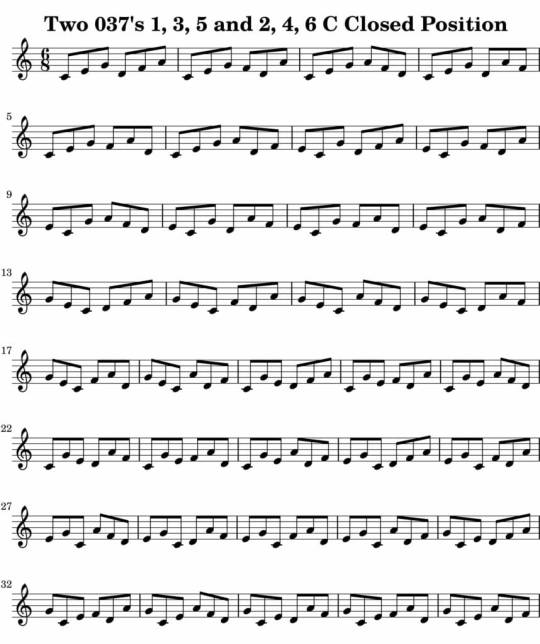
MP3 example
https://s3.amazonaws.com/media.muse-eek.com/mp3/HandMEV19A/01_037_Degree_1_3_5_2_4_6_Closed_Position_Key_C.mp3
1st Inversion Exercise
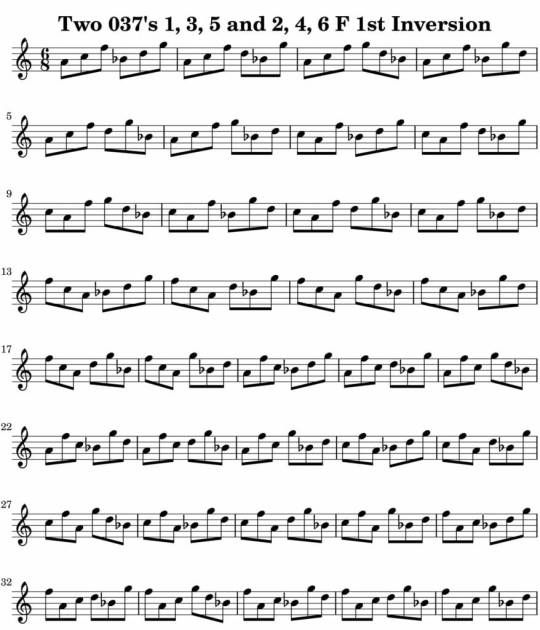
MP3 example
https://s3.amazonaws.com/media.muse-eek.com/mp3/HandMEV19A/02_037_Degree_1_3_5_2_4_6_1st_Inversion_Key_F.mp3
2nd Inversion Exercise

MP3 example
https://s3.amazonaws.com/media.muse-eek.com/mp3/HandMEV19A/03_037_Degree_1_3_5_2_4_6_2nd_Inversion_Key_Bb.mp3
Random combinations of closed position along with 1st and 2nd inversion.
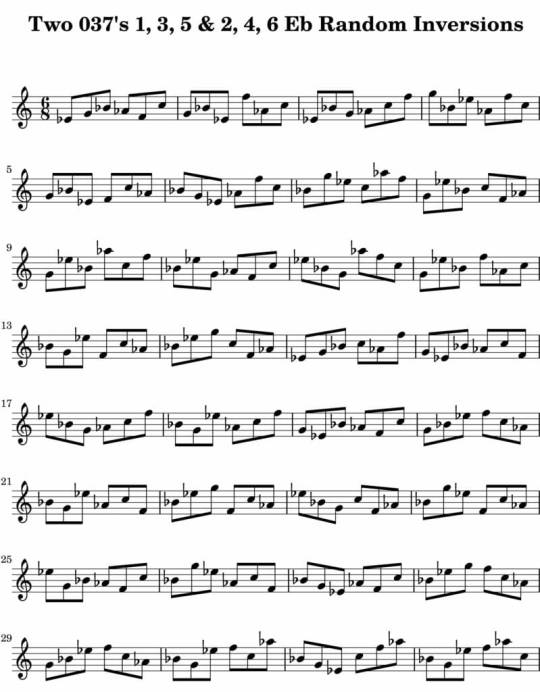
MP3 example
https://s3.amazonaws.com/media.muse-eek.com/mp3/HandMEV19A/04_037_Degree_1_3_5_2_4_6_Random_Inversions_Key_Eb.mp3
Random combinations of closed position along with 1st and 2nd inversion and rhythm permutation
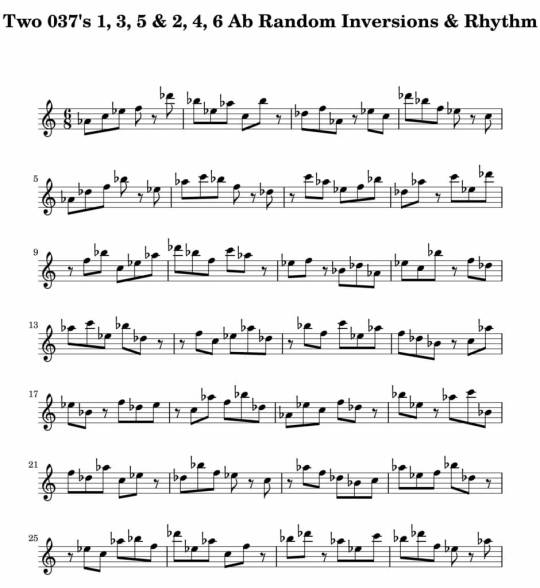
MP3 example
https://s3.amazonaws.com/media.muse-eek.com/mp3/HandMEV19A/05_037_Degree_1_3_5_2_4_6_Random_Inv_Rhy_Key_Ab.mp3
2nd Set of Exercises in Harmonic and Melodic Equivalence V19A Course
Here are a few examples from the 2nd set of exercises.
Atomic Scales 1st Rotation
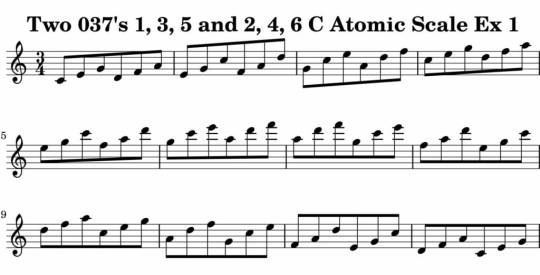
MP3 example
https://s3.amazonaws.com/media.muse-eek.com/mp3/HandMEV19A/01_037_Degree_1_3_5_2_4_6_Atomic_Scale_Ex_1_Key_C.mp3
Atomic Scales 2nd Rotation
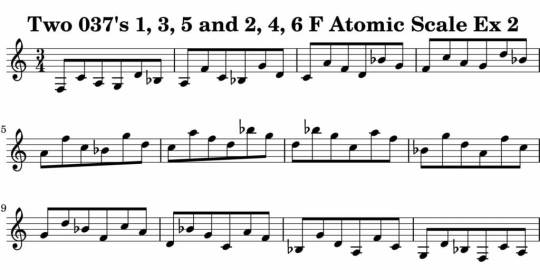
MP3 example
https://s3.amazonaws.com/media.muse-eek.com/mp3/HandMEV19A/02_037_Degree_1_3_5_2_4_6_Atomic_Scale_Ex_2_Key_F.mp3
Atomic Scales 3rd Rotation
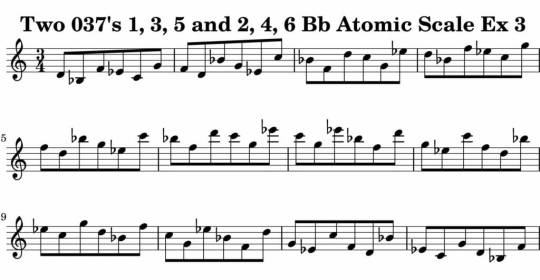
MP3 example
https://s3.amazonaws.com/media.muse-eek.com/mp3/HandMEV19A/03_037_Degree_1_3_5_2_4_6_Atomic_Scale_Ex_3_Key_Bb.mp3
Atomic Scales 4th Rotation
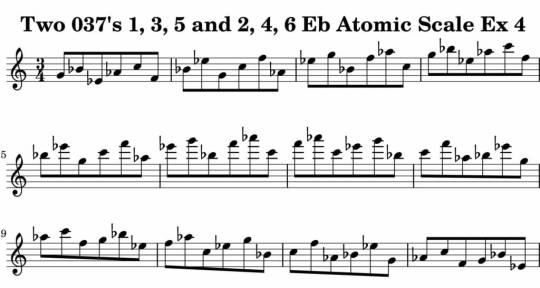
MP3 example
https://s3.amazonaws.com/media.muse-eek.com/mp3/HandMEV19A/04_037_Degree_1_3_5_2_4_6_Atomic_Scale_Ex_4_Key_Eb.mp3
Atomic Scales 5th Rotation
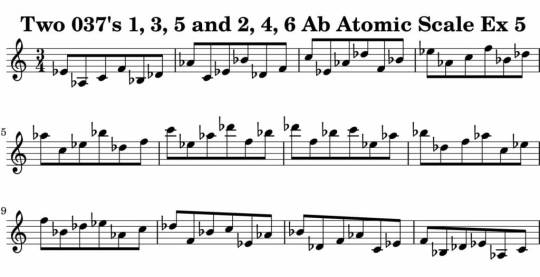
MP3 example
https://s3.amazonaws.com/media.muse-eek.com/mp3/HandMEV19A/05_037_Degree_1_3_5_2_4_6_Atomic_Scale_Ex_5_Key_Ab.mp3
Atomic Scales 6th Rotation

MP3 example
https://s3.amazonaws.com/media.muse-eek.com/mp3/HandMEV19A/06_037_Degree_1_3_5_2_4_6_Atomic_Scale_Ex_6_Key_Db.mp3
TOC in the Harmonic and Melodic Equivalence V19A Course:
How to Use This Course
Harmonic/Melodic Possibilities of Two 037's
Chord Possibilities of Two 037's
Rotations Starting on Every Eighth Note
Two 013's in Modal Playing
How to Think of the 013's Used in This Course
013 Daily Exercise-Atomic Scales
Thinking of the Trichords as Modes
Thinking of the Trichords as One Scale
C, E, G and D, F, A as One Scale in All Keys
Get Harmonic and Melodic Equivalence V19A Today!
Add digital copy to cart - $19.99
Status: In stock, Digital book is available for immediate access.
Additional Information for Harmonic and Melodic Equivalence V19A:
Digital Edition 978-1-59489-334-6
One 8 page PDF explaining exercises, 5 different types of exercises, 328 pages of exercises in PDF format in treble and bass clef
MP3's and Midi files for all exercises.
12 MP3s from Tuba MetroDrone®
What people are saying:
OK I'm a big fan of the band "Weather Report" and these two triad things are exactly what Joe Zawinal is doing during his improvisation...among other things of course. This is a great study Bruce! Thanks for pointing it out to me and showing me some places where it is used J. Ogland
I've been following your "Harmonic and Melodic Equivalence Series" and this volume is what sold me on the idea. There are some really cool melodies here that you can combine with pentatonics or blues. Thanks for making the course! R. Andersen
Hey just wanted to give you a shout out that I'm digging the atomic scales in these courses. That is an awesome technique that I can directly translate to my soloing. A. Newburg
Such a cool series Bruce. Thanks for creating these and making so many of these examples available on line K. Wilkes
Read the full article
0 notes
Text
Pitch Class Set Jazz Standards

Pitch Class Set Jazz Standards
Pitch Class Set Jazz Standards
Pitch Class Set Jazz Standards is an intriguing idea that I'd like to discuss in this blog post. There are many ways to apply pitch class sets to jazz and I'd like to start with looking at the Jazz standard "Stella By Starlight" and explore some possible uses.
If we look at the melody to "Stella By Starlight" and analysis the interval content we find a preponderance of the pitch class set "013." (013's contain a 1/2 step and a minor 3rd) This is not unique to just this jazz standard it happens in many jazz standards because many of the Tin Pan Alley composers where studying with Classical teachers and of course they all wanted to be Stravinsky :) In any case it is not surprising that many jazz standards have a lot of internal structure. Most great music does.
Using Pitch Class Set Jazz Standards Information To Play More Compositional
Using pitch class set jazz standards information To Play More Compositional when improvising both chords and melodies is an obvious way to make your playing more connected to the music. Since "Stella By Starlight" melody contains mostly 013 pitch class sets why not use 013 chords and melodies for the tune. Think of it like playing off the melody on steroids. This of course isn't something you can do overnight but if you start to study the use of 013 over various chord types over time you will get enough technique that you can tackle putting this information over an entire jazz standard.
How to Master Pitch Class Set Jazz Standards Information
There are many ways to master pitch class set jazz standards information and I've written quite of few books that show the relationships of how pitch class sets interface with the chords and scales found in jazz standards. Some are reference books and some are methods books directly applying pitch class sets to typical jazz standard chord progressions or actual standards. The important thing is to organize this so that you don't get overwhelmed because believe me it is easy to become overwhelmed when you see all the possibilities.
One Step at a Time
I usually don't start students interested in pitch class set jazz standards on the 013 pitch class set. This is mostly because the learning curve and the amount of time it takes to make this pitch class set sound good is a bit long. I commonly use 027 pitch class set as an introduction because you can start improvising with this within a few weeks. 027 works great on many jazz standards too but certainly not as many as 013 which in the 1st Real Book there are over forty jazz standards that have a preponderance of 013. The next most common pitch class set would be 025 which again weighs in at about 40 jazz standards in the Real Book 1 that mostly use this pitch class set.
Step One Pitch Class Set Jazz Standards
A common way I start students working on 013 is take a hexatonic scale and make that into to trichords. (non-tertial triads) The octatonic scale I call Symmetrical Diminished 1, b2, b3, 3, #4, 5, 6, b7 also contains a preponderance of 013 and is a widely used scale in jazz and heavy metal for that matter. So if we take a C Symmetrical Diminished and only use 1, b2, b3, #4, 5 and 6 we have two 013's. 1, b2, b3 and #4, 5, 6. If you play a chordal instrument like guitar or piano learn the chord voicings of 013. I've written a series of books to help you do this:
Applying 013 Chord Voicings-Application of Pitch Class Set Theory to Traditional Harmony
Applying Pitch Class Set Chord Voicings to Traditional Harmony
Modal Pitch Class Set Chord Voicings
Modal Chromatic Pitch Class Set Chord Voicings
Some of these books above also cover other pitch class sets so see the examples and audio files to make your choices.
Technical Exercises for 013 Pitch Class Set
Play the two trichords ascending and descending in the following way:
1, b2, b3
b2, b3, (1 up an octave)
b3, (1 and b2 up an octave)
#4, 5, 6.
#4, 5, 6.
5, 6, (#4 up an octave
6, (#4 and 5 up an octave)
If you want a more detailed way of doing this. Atomic Scales shows you how to do this for 027 027 which you can use as a template for all pitch class sets. This is particularly good if you play guitar.
I should also mention that if you want to find out all the information about the 013 013 pitch class sets I just mentioned I would highly recommend the Sonic Resource Guide. Think of that book as a reference guide to all possible scales i.e. pitch class sets. It also shows you what chords fit over every possible scale as well as hextaonic/trichord splits for all six and seven note scales. It includes a primer on understanding pitch class sets.
Composing with Pitch Class Sets
Don't overlook the idea of composing with pitch class sets. I've written over 30 compositions using 013. Check out the Bruce Arnold Composition Compilation to see scores and recordings. You could also check out the two books below which give you detailed analysis of how I composed many of my compositions and organized my improvisations.
MY MUSIC: Application of 12 Tone Techniques to Jazz Composition and Improvisation
Tools for Modern Improvisation
Other Pitch Class Sets Books
I've also written some method books to help you see further uses of pitch class sets. Many of them deal specifically with 013
Trichord Sweep Pairs Guitar Instrumentalist Sweep Arpeggios
Symmetrical Trichord Pairs
720 Sweep Arpeggio Patterns for Instrumentalists
Guitar Arpeggio Lexicon
Ultimate Arpeggio 3 Note Combinations
Ultimate 3 Note Chord Lexicon
013 Hexatonic Études: Pitch Class Set Exercises for Dominant 7th Key Center
Many ChopBusters Courses
Set Theory for Improvisation Ensemble Method: Hexatonic 027 016
Set Theory for Improvisation Ensemble Method: Hexatonic 027 027
Intervallic Series
Tertial Octatonics
Time Transformation
Improvising over Classical Music Masterpieces
Conclusion
You can see that the idea of pitch class set jazz standards opens up a big subject. I recommend you contact me for recommendations on how to get started based on the amount of time you have available. Please send me an email and I'll give you some advice.
Bruce Arnold Music Education Genealogy Chart
You might enjoy checking out the “Music Education Genealogy Chart” located on my artist’s site. You will clearly see the historic progression of pedagogy that is the basis for Muse Eek Publishing Products. Great musicians throughout history have been studying the ideas presented by Muse-eek.com which derives its content from a a lineage that stretches back to Scarlatti!

Read the full article
0 notes
Text
Scale Analysis
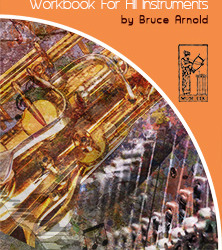
Scale Analysis
Scale Analysis is a mega course that melds your aural comprehension with your intellectual understanding of scales, keys and chords into one unified whole.Scale-Analysis-by-Bruce-Arnold-muse-eek.com700 Page PDF, 36 Videos: Over 4 hours of video, 108 MP3s and 72 Midifiles.Add digital copy to cart - $69.99
Scale Analysis
Scale Analysis is hands down the most comprehensive course on the subject of ear training and how it applies to hearing chord progressions and scales. It will teach you to hear multiple scales and chords all within a key center. This skill will revolutionize your improvisations and compositions and change your whole approach when working with chords and scales.Please Note: We recommend that all guitarist work with the Guitar Technique and Physiology Course so that you learn with proper scale technique. This course gives you a comprehensive approach to playing guitar and includes a videos on all aspects of guitar technique.
Overarching Goal
As stated, the overarching goal behind the Scale Analysis course is to teach you how to hear multiple chords all in one key center. By honing this ability you will find improvising over chords to be much simpler and more musical at the same time. Initially, this course presents a way to understand how you should hear chords and their associated chord scales. Secondly, it develops your ear so that you are truly hearing and playing using these concepts.
The Key is the Key
This idea of hearing entire chord progressions within a key center is not new. Take a look at any jazz standard or pop tune and you will find a melody that is largely diatonic to a key center while multiple chords are present. Unfortunately, most educational systems use a cookie cutter approach to understanding and playing over chord changes, wherein each chord is its own key center. In other words, the root of each chord is thought of as the new key center.
Simplify but at the same time Expand Your Improvisation
This concept of playing leads to a very vertical conception of “playing over the changes” and makes creating a key-based, melodic solo very difficult, if not impossible. This vertical approach also goes against how you ultimately hear music and will become apparent as your ear progresses with the “Contextual Ear Training” courses that I’ve created. Working with "Scale Analysis" will speed up your ability to hear scales and chords in one key center. Targeted exercises instill both an intellectual understanding of these musical elements, as well as strengthening your aural skills so that you actually start to hear the correct way.
Each Chord influences the Next Chord
The second major premise is that when you have multiple chords within a chord progression each successive chord and the scale chosen for that chord will affect which scale you use for the next chord. This is because your ear tends to want to hold on to any sound it hears until it is canceled out by another sound. This canceling sound is usually a chord tone on the next chord. A quick example: If you have a C Dominant 7th chord and you play a C Mixolydian scale over it, if you then hear an F7 chord the “Eb” in the F7 chord will cancel out the “E” in the Mixolydian scale, creating a C Dorian scale. So you can see that we are thinking of both chords in the key of C.
Example of Chord Following Chord
There will of course be exceptions to this; for example, if you play the C Dominant chord for a couple of measures and then play the F7 chord for eight measure at some point you stand a good chance of modulating to the key of F. This is completely fine! The idea is that the longer you hear a chord the more chances you have to modulate to the root of that chord. And the faster the chords are presented, the more you stand the chance of hearing all the chords in one key center. In most cases musicians need work on hearing a group of chords and their chord scales in one key center and that is the backbone of this course.
Additional Information Found in This Course
The above video gives you examples of different parts of the book, but besides the worksheet where you write out the scales, there are many other aspects of the course that give you extremely valuable information about chord scale relationships, such as:A list showing you which chords tend to be used with specific scales when you relate them to one key center.A index showing you the location of the scales and their related chords within 36 chord progressions so you can see patterns.A list showing you all possible chord scale relationships for each scale used in the 36 chord progressions.A index showing you all possible subsets for the scales used in the chord progressions.A list showing the South Indian “Melakarta” scales and their relationship to the scales used in this course.A index of all alternate names used for the scales found in this course.Additional ear training exercises which help you apply the techniques you have learned to popular tunes or your own compositions.
Dig Deeper into Scale Analysis
"Scale Analysis" covers the subsets for 109 scales. These subsets are very useful for applying other techniques of improvisation, instead of playing the scale as we normally do when improvising. Here are some concepts that you could use to apply these subsets.
Two Notes:
The two note combinations help you see different interval combinations that you can use to represent the scale.Here is a partial list of dyads from the C Major Scale:Major Scale Partial List of 2 Note Subsets of Major Scale Interval Names PrimeForm0,2, C,D, 0,20,4, C,E, 0,40,5, C,F, 0,50,7, C,G, 0,50,9, C,A, 0,30,11, C,B, 0,12,4, D,E, 0,22,5, D,F, 0,32,7, D,G, 0,52,9, D,A, 0,52,11, D,B, 0,34,5, E,F, 0,1Many improvisational concepts can be derived from dyads. For instance if you took all 1/2 steps (i.e. 0,1 PrimeForm) and combined them with all fifths (i.e. 0,5 PrimeForm) you will get a very modern intervallic sounding C Major scale melody.
Three Notes:
Use any of the three note combinations to represent a chord (make sure there are no avoid notes in the three note chord) or an arpeggio (this could contain an avoid note). Then use two 3 note combinations to create an alternating sound of moving back and forth between these two 3 note groups. Use them as chords or melody. In the book "Time Transformation" I use 1,2,5 and b3,4,b7 as the two 3 note groups and provide études to apply this sound over a minor chord vamp. It's a very modern, hip sound!Use the two 3 note combinations without any repeated notes and do the same as above. This creates a Hexatonic scale. Create chord progressions with these 3 note chords. These 3 note chords work really beautifully in modal situations. You can hear examples of this concept on many of my recordings. For instance, I use these ideas in a jazz setting in Art of the Blues and in a Rock/Heavy Metal setting in Vanishing Point. You can also hear the use of a Hexatonic Scale 027-027 during my solo on the jazz standard "Invitation" on Two Guys from South Dakota.Three note combinations open up a whole world of improvisational concepts. Below is a partial list of Trichords (3 note chords) from the C Major Scale.Major Scale Partial List of 3 Note Subsets of Major Scale: Interval Note Names Prime Form0,7,11, C,G,B, 0,1,50,9,11, C,A,B, 0,1,32,4,5, D,E,F, 0,1,32,4,7, D,E,G, 0,2,52,4,9, D,E,A, 0,2,72,4,11, D,E,B, 0,2,52,5,7, D,F,G, 0,2,52,5,9, D,F,A, 0,3,72,5,11, D,F,B, 0,3,6There are too many improvisational concepts that can be derived from trichords to list here. But here is a great combination for chords or melodies. Take the C,G,B (0,1,5 PrimeForm) and combine it with D,E,A (0,2,7 Primeform). Pivot back and forth between these two groups and you have a wonderful sound that can literally be used in any idiom. You can hear this two trichord concept used in many ways on the following recordings:Use this two triad concept to create compositions: Listen to DuetsIt is used to improvise over modern classical music on the Webern CD.To hear examples of using 025-025 trichords to create down home blues compositions; check out Tarnation, Widow Maker, Windies, Wagtail, Dakota Train Blues and Asher from Great Houdini.Hear it used in a free improvisational setting with 014-014 trichords on "Remembrances" from "Listen to This".013-013 as a lyrical counterpoint on the composition "Blue Lotus" from the same titled CD.Check out "Tools for Modern Improvisation" for many more examplesI should also mention "Symmetrical Trichord Pairs" which is a very useful method book for exploring this concept.
Four Notes:
Four note combination again have many uses. Here is an abbreviated list:Use any of the four note combinations to represent a chord (make sure there are no avoid notes in the four note chord) or an arpeggio (this could contain an avoid note.) Use two four note combinations to create an alternating sound of moving back and forth between these two four note chords or melody. See the “Tertial Octatonics” course for examples of this concept.Use the two 4 note combinations without any repeated notes and do the same as above. This creates an Octatonic scale. See the “Tertial Octatonics” course for examples of this concept. Create chord progressions with these four note chords. These four note chords work really well in modal situations.Here is a partial list of Tetrads (4 note chords) from the C Major ScaleMajor ScalePartial List of 4 Note Subsets of Major Scale: Interval Note Names PrimeForm0,2,4,5, C,D,E,F, 0,1,3,50,2,4,7, C,D,E,G, 0,2,4,70,2,4,9, C,D,E,A, 0,2,4,70,2,4,11, C,D,E,B, 0,1,3,50,2,5,7, C,D,F,G, 0,2,5,70,2,5,9, C,D,F,A, 0,3,5,80,2,5,11, C,D,F,B, 0,1,3,60,2,7,9, C,D,G,A, 0,2,5,70,2,7,11, C,D,G,B, 0,2,3,70,2,9,11, C,D,A,B, 0,2,3,50,4,5,7, C,E,F,G, 0,2,3,70,4,5,9, C,E,F,A, 0,1,5,80,4,5,11, C,E,F,B, 0,1,5,60,4,7,9, C,E,G,A, 0,3,5,8Again there are too many improvisational concepts that can be derived from Tetrads to list here. Here are a couple of ideas:Use the C,D,E,G, (0,2,4,7 PrimeForm) to outline chords as John Coltrane did in “Giant Steps.” But why not use C,D,E,A, C,D,E,B, C,D,G,A, C,D,G,B, etc... to create other ways of arpeggiating through a song?You could also use a three tetrad concept called "23rd chords." In this concept you use three 4 note chords to represent a chord. (which creates a 12 tone aggregrate) I use this idea on the composition "Blue Eleven" from the same titled CD. You can find a full list of 23rd chords in the book "Tools for Modern Improvisation."
Five Notes:
Five notes is a Pentatonic scale. In the Scale Analysis course you can see all Pentatonic scales that could be used rather than the larger six, seven or eight note scale. Applying modal sequencing on these Pentatonic scales can create some very engaging sounds. (See the “Two Note Modal Sequencing" and "Three Note Modal Sequencing” courses for more information on using these type of patterns.)Here is a partial list of Pentads (5 note chords) from the C Major ScaleMajor Scale Partial List of 5 Note Subsets of Major Scale: Interval Names PrimeForm0,2,4,5,7, C,D,E,F,G, 0,2,3,5,70,2,4,5,9, C,D,E,F,A, 0,1,3,5,80,2,4,5,11, C,D,E,F,B, 0,1,3,5,60,2,4,7,9, C,D,E,G,A, 0,2,4,7,90,2,4,7,11, C,D,E,G,B, 0,1,3,5,80,2,4,9,11, C,D,E,A,B, 0,2,3,5,70,2,5,7,9, C,D,F,G,A, 0,2,4,7,9You can think of Scale Analysis as your ultimate guide for pentatonic scales. It is of course common to use a C,D,E,G,A Pentatonic scale as a replacement for a C Major Scale. But why not use some of the other combinations from this list like:C,D,E,G,B, (0,1,3,5,8 PrimeForm)C,D,E,A,B, (0,2,3,5,7 PrimeForm)
Six Notes:
This shows you all the Hexatonic scales that can be created from the parent scale. This is very useful for creating alternative melodies. Again, sequencing these Hexatonic scales creates very interesting melodies. Pick a Hexatonic scale with no avoid notes, and you have a super useful scale because you never have to worry about which note you are stopping on.Here is a partial list of Hexads (6 note chords) from the C Major Scale:Major Scale Partial List of 6 Note Subsets of Major Scale: Interval Names PrimeForm0,2,4,5,7,9, C,D,E,F,G,A, 0,2,4,5,7,90,2,4,5,7,11, C,D,E,F,G,B, 0,1,3,5,6,80,2,4,5,9,11, C,D,E,F,A,B, 0,1,3,5,6,80,2,4,7,9,11, C,D,E,G,A,B, 0,2,4,5,7,90,2,5,7,9,11, C,D,F,G,A,B, 0,2,3,5,7,90,4,5,7,9,11, C,E,F,G,A,B, 0,1,3,5,7,82,4,5,7,9,11, D,E,F,G,A,B, 0,2,3,5,7,9Hexatonic scales are used widely in contemporary improvisation. C,D,E,G,A,B, (0,2,4,5,7,9 PrimeForm) is used often. But why not borrow C,D,E,F#,A,B, (0,2,3,5,7,9 PrimeForm) and use that in the many ways you can organize a hexad?
Seven Notes:
These scales only exist where there is an Octatonic scale. Using a 7 note subset often creates a most intriguing sound. It helps to find melodies that are not as symmetrical, particularly when you are playing an eight note symmetrical scale.Don’t overlook the use of heptads as a replacement for an Octatonic scale. For instance instead of a C Symmetrical Diminished Scale: C,Db,Eb,E,Gb,G,A,Bb (0,1,3,4,6,7,9,10 PrimeForm) use this heptad: Db,Eb,E,Gb,G,A,Bb (0,1,3,4,6,7,9 PrimeForm)
Just a Few Examples
The lists and ideas above are taken from only two scales: Major and Symmetrical Diminished. Scale Analysis contains 109 different scales which will provide you with a lifetime of investigating and applying awesome alternative ideas with scales and their subsets.
Get Scale Analysis Today!
Scale Analysis
ISBN: 978-1-59489-431-2700 Page PDF, 36 Videos: Over 4 hours of video, 341 MP3s and 72 Midifiles.Add digital copy to cart - $69.99What people are saying:This is an fantastic course! It's a simple concept but after working with it, it has really changed the way I hear and think about music. C. Franks The most enlightening book on music that I've ever read. I now understand how to hear scales within chord progressions. This is awesome! Thanks! W. KimHearing all scales in one key is an entirely new approach for me and it's really working. Why doesn't everyone teach this? A. RosenthalI'll be referencing this book for a long time. Amazing amount of information! Thanks for including the list showing all the subsets of the scales that is super valuable. F. Nathan
Have a story or a review you want to submit. We would love to hear from you please send us an email.
Read the full article
#pitchclassset#auraltraining#chordprogressions#Scaleanalysis#hearingchords#auralrecognition#hearingscales#eartrainingscales
0 notes